June 4 - 10, 2017: Issue 315
The Postponed America's Cup Of 1914: Bermuda Once A Refuge For The British Shamrock IV And An Australian RPAYC Commodore Part Of The Trials Crew
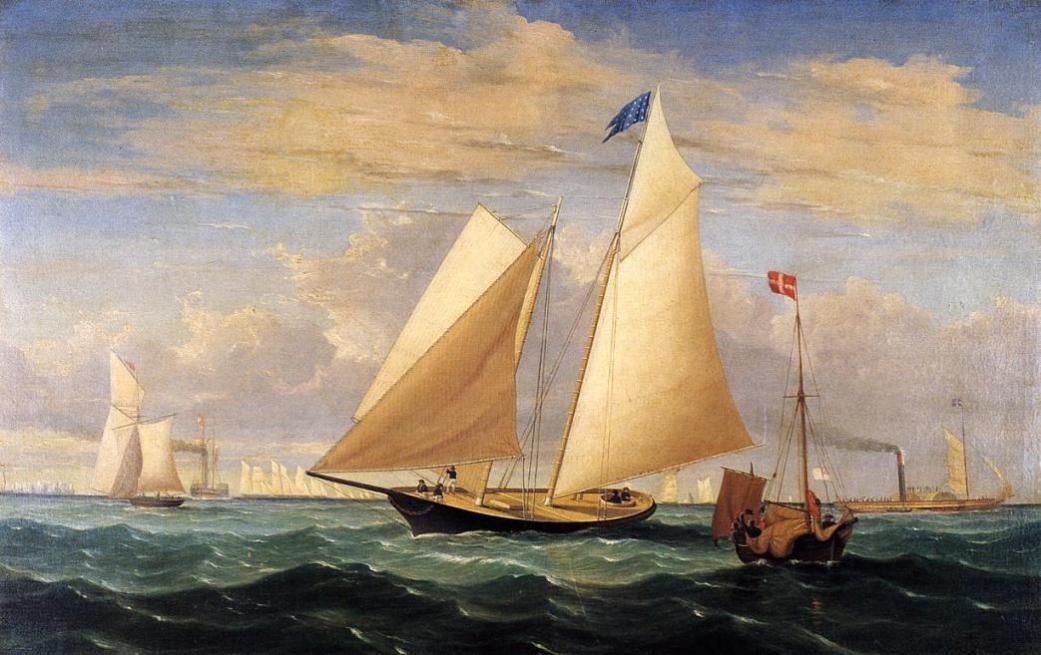
"The Yacht 'America' Winning the International Race," oil on canvas, by the American artist Fitz Hugh Lane. Courtesy of the Peabody Collection.
At present the America's Cup qualifying races are being conducted for the 35th running of this historical sailing event which remains the cup everyone would like to win in sailing, apart from a Sydney to Hobart of course!
Among the brilliant sailors a number of Australians, including members of the Royal Prince Alfred Yacht Club, are vying to be part of the records in this historical event. Most people are aware that Australia II was the first successful challenger to win the America's Cup. How many are aware who was the first Australian to be involved with this great old race though?
As a maritime nation, and an aquatic community, there were probably a few involved in early America's Cup challenges and races that remain slightly hidden at present as so much of these great events focuses on the beautiful vessels and their skippers/captains/owners/designers/shipwrights, not those sailing on them. An 1870 report in The Australasian from someone aboard the Vectis steamer, which followed the races, signed "O.K." obviously had some connection here - but whom is 'O.K.'? Other reports are not signed at all, nor do they contain much or any information about those contesting the races as crew until later contests.
We can confirm one Australian as being involved in the year it didn't happen - 1914 - due to the outbreak of World War I while the yacht that was to sail as challenger was mid-ocean. The Shamrock IV, a Sir Thomas Lipton beauty, took refuge in Bermuda for a few days prior to sailing north to New York, so another connection echoes this year's 35th Auld Mug races in this. Among those aboard her accompanying vessel, the Erin, was Walter Moffit Marks, then Commodore of the RPAYC and a gentleman who had taken part in her sailing trails prior to departing England for America but was excluded from sailing in the races that didn't happen anyway.
The article below illustrates our current Australian sailing champions are not the first to be involved in America's Cup campaigns from the club where 'Excellence in Sailing' has always been a focus, particularly the advancement of sailing in the community and the equipment it may be achieved in.
The RPAYC has a history of introducing new classes of vessels and remains, in its Youth Development and Adult Sailing ventures committed to giving opportunities to those who wish to do their best in the sport either as competitors or simply as recreational sailors.
The article is written by John Roche, born 1884 to James and Katherine Roche (nee Collins) of Bayview, known during his years of guiding Pittwater Regattas as 'the Father of the Pittwater Regatta' as well as 'The Prince of Pittwater'.
One of the predecessors of the current generation of champions on the water may possibly be smiling over this year's sailors - he would certainly be immensely happy with the 2017 context and development of the Pittwater club:-
The Yachting Authority, JOHN ROCHE, Writes of
THE AMERICA'S CUP TO-MORROW'S GREAT INTERNATIONAL RACE
YACHT racing history was made eighty years ago, when an English merchant suggested to some American business men that one of the famous New York pilot schooners, which held a great reputation for speed among British sailormen, should be sent to England to compete In the regattas which were to be an auxiliary feature of a world's fair, planned to be an exposition of the world's progress in arts, manufacturers, and sporting activities to be held In London in the year 1851. A syndicate of six members of the New York Yacht Club accepted the suggestion, and built a schooner yacht of 170 tons, which was designed to be faster than any of the pilot boats. Launched In June, 1851, and christened America, the new yacht proved to be exceptionally fast in trial races. Hearing of the project, the members of the Royal Yacht Squadron. England, extended to the owners of the America a cordial Invitation in visit the Squadron Club House at Cowes, and participate in their racing programme. This was accepted, and. on June 20, 1851, the America cleared New York Harbor bound for Havre, France, making the voyage in 17 ½ days.
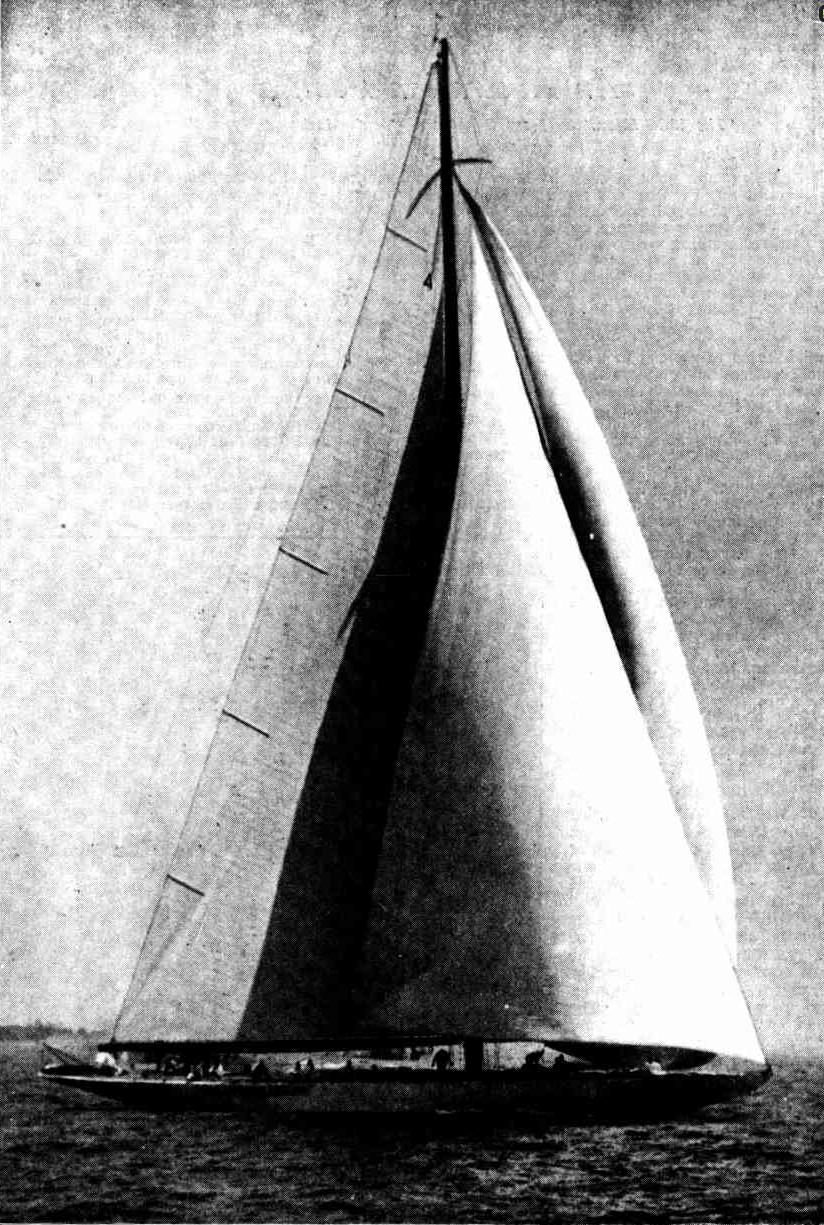
The American defender, Enterprise.
She was the first yacht to sail across the Atlantic Ocean. Three weeks were spent refitting at Havre. The America then crossed the Channel, and came to an anchorage off Cowes. Her unorthodox hull design and sails created great interest among British yachtsmen.
With the object of testing the relative merits of the different models of yachts the members of the Royal Yacht Squadron of England subscribed a Cup, valued at £100, for a race open to yachts of all nations, to be sailed over a 53 miles course round the Isle of Wight. A special Invitation to compete was extended to the owners of the America and accepted by them.
On Friday, August 22, 1851 thirteen British yachts opposed the America in the race for the Royal Yacht Squadron Cup. The America outclassed the British yachts, winning the race by 24 minutes. The Cup was presented to Commodore Stevens of the New York Yacht Club, one of the syndicate of owners of the America.
In historic importance this first race for the Royal Yacht Squadron Cup now known as the America’s Cup, surpasses all other events of yachting. Its influence on the sport at large, on the progress of design, construction, rigging and sail-making can hardly be estimated. It revolutionized the design of British yachts and marked the beginning of real yacht racing, or perhaps, more correctly speaking, the systematic racing of yachts built for that purpose as well as for cruising.
The victory of the America over the champion yachts of England was also the beginning of that spirit of connection between the yachtsmen of England and of America which has been attended by so much benefit to the sport of yacht racing. The America Cup is regarded as the emblem of the supremacy of the seas in a yachting sense –its possession being frequently contested.
The owners conveyed the Cup in 1857, by deed of gift, to the keeping of the New York Yacht Club as a perpetual Challenge Cup, to be known as the America’s Cup, for friendly competition between sailing yachts belonging to yacht clubs of foreign countries.
In the year 1870-71 British yachts made unsuccessful attempts to bring back the Cup to England. Canadian yachts challenged unsuccessfully in 1870 and 1881.
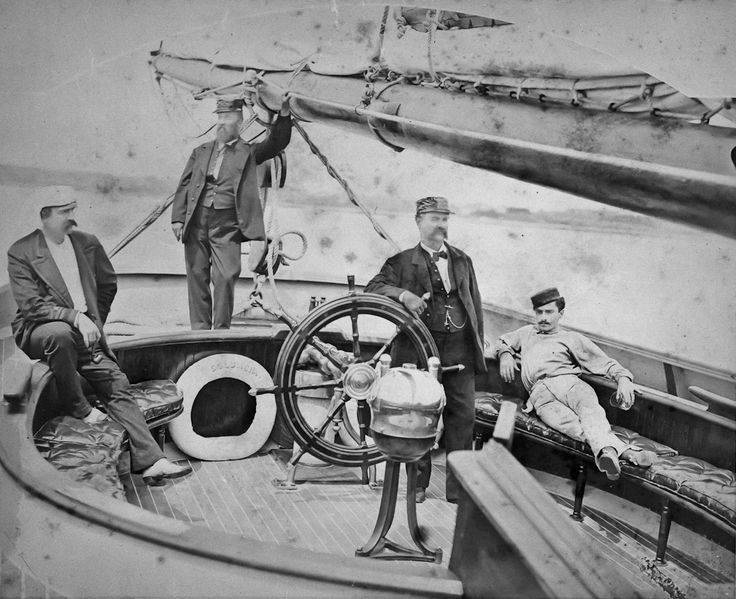
Photograph of Andrew Jackson Comstock at the wheel of the racing schooner, Columbia, circa 1880 (Detail)
Andrew Jackson Comstock was one of several Comstock brothers from New London who were accomplished racing yacht masters. Comstock was skipper of the racing schooner Columbia, which defended during the 1871 America’s Cup challenge. (He was also skipper of the Magic, the successful defender of the 1870 Cup.) Columbia won the first two races against the challenger, the Livonia. Columbia, damaged during the second race, was beaten by the Livonia in the third race. However that race was won by another American yacht, the Sappho. Thus, together, the Columbia and Sappho successfully defended the Cup. A newspaper article of the time noted: "The crew (of the Columbia), numbering thirteen, is under the command of Captain Andrew Comstock, one of the most experienced and best sailing masters in the country.... (T)hey evidently understand their business thoroughly. In fact, if they didn't, they would not be long on a craft with Captain Comstock in command."
This unique photograph was found in the scrapbook of Mrs. Mary Chapman Comstock, wife of Andrew Jackson Comstock. The scrapbook was among the items left to the New London Custom House Maritime Museum by Mrs. Margaret Thoms, great granddaughter of Andrew Jackson Comstock.
British yachtsmen again failed in 1885, 1886, and 1887. In 1893-95 Lord Dunraven was unsuccessful with Valkyrie II. and III. Sir Thomas Lipton challenged in 1899 with Shamrock and was beaten by the American defender Columbia in three consecutive races.
In 1901 Sir Thomas Lipton challenged with Shamrock II., Columbia repeating her previous successes. With Shamrock III. Sir Thomas Lipton was decisively beaten by the American defender, Reliance in 1903.
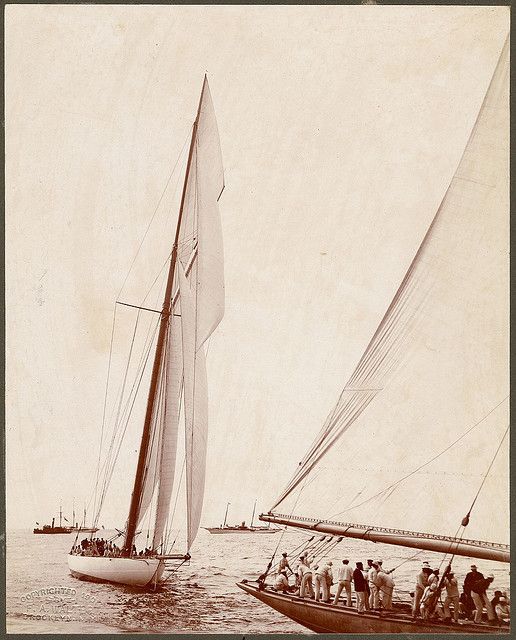
Columbia and Shamrock II - 1901 America's Cup
Undaunted, Sir Thomas Lipton challenged again in 1914 with another new yacht, Shamrock IV. Although the challenge was accepted and the date for the contests arranged, grave circumstances of world-wide importance caused a postponement. An unalterable clause of the deed of gift relating to the America's Cup states that yachts selected to compete for the Cup must proceed on their own bottoms to the port where the contest is to take place.
Between 1870 and 1903 the eleven British challengers experienced uneventful voyages across the Atlantic to New York. Shamrock IV., the twelfth British challenger, left Portsmouth on July 21, 1914, bound for New York to compete in the Cup contests arranged to be held in September. 1914. Convoying Shamrock IV. was Sir Thomas Lipton's steam yacht Erin.
Among her passengers was Mr. Walter M. Marks, a well-known Australian yachtsman, the then title-holder of the Sayonara Cup, which is recognised as the America's Cup of Australian yachting. Mr. Marks’ presence was due to a special invitation extended by Sir Thomas Lipton to sail as a representative of Australia on board the Shamrock IV. in the Cup races.
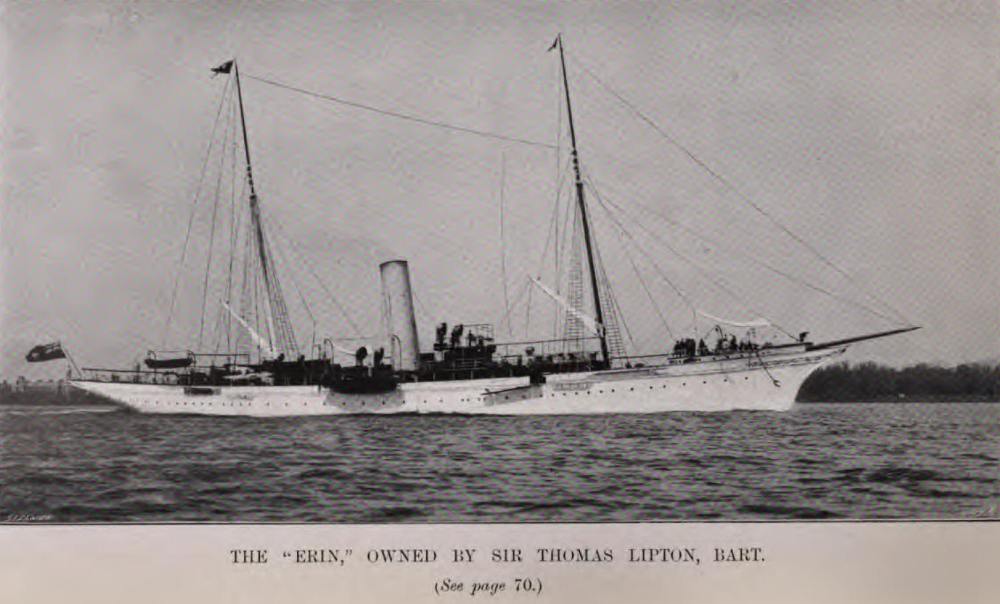
Making a good passage, Shamrock IV. and Erin arrived at the Azores on July 28. The voyage was continued the following day. Good progress was being made when, on August 4, the wireless operator on the Erin picked up a momentous message which read: 'England has declared war.' Shamrock IV. was, on that memorable date, fighting her way through a heavy gale in the mid-Atlantic Ocean. Consternation reigned for the safety of the two yachts when a few minutes later, Erin's wireless operator picked up a message that a German Atlantic fleet were about 500 miles away between the course of the two yachts, and New York.
Later on in the night a coded message was picked up from New York, which read as follows: 'Shamrock and Erin to seek shelter at nearest British port immediately.'
The Bermudas were 400 miles to the sou'-west of the position of the yachts. It was decided to make for Bermuda. A tow line was passed from the Erin to the Shamrock, a difficult job in the heavy sea. With a following wind the Erin made fast time with her charge. In the meantime the wireless from the German fleet was becoming less distinct, thus indicating that the yachts were moving towards safe quarters. After a 72-hours' tow the yachts reached, on August 9, a haven of safety behind a section of the British Fleet moored in Bermuda Harbor.
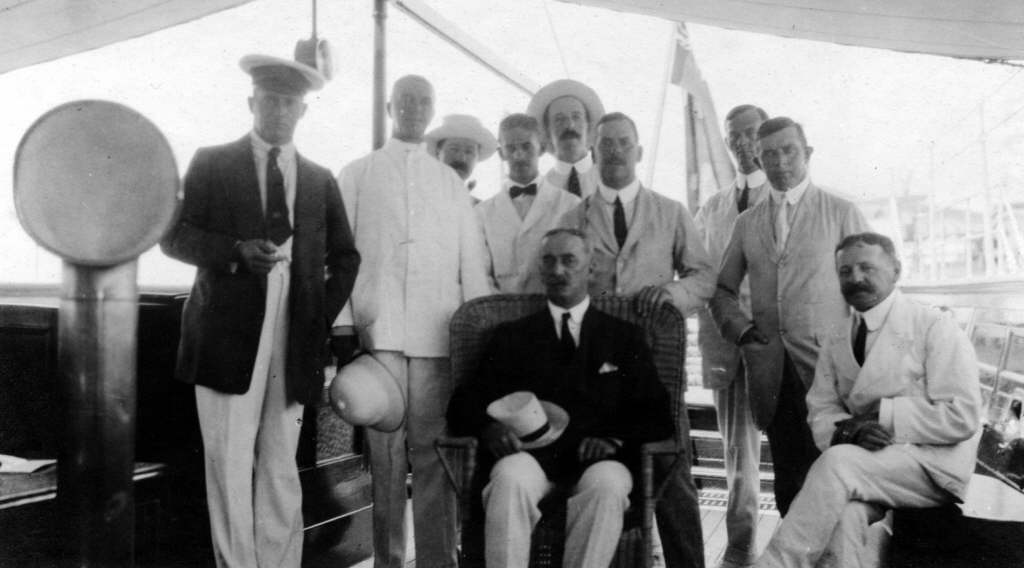
Guests on Erin, Bermuda. Lord Hardincke, Walter Marks, Colonel Neill, Commander Hamilton, Commander Gooling RBYC and Mayor of Bermuda. August 1914. Image courtesy of the Mitchell Library, Glasgow.
On August 12 a message from the British Admiralty was received instructing the captain of the Erin to proceed to New York with the Shamrock in tow. A start was made on August 13, and the journey was safely accomplished in four days. Upon arrival in New fork Harbor a tumultuous welcome greeted the two yachts and their crews.
The races for the Cup were postponed. Shamrock IV. was slipped and dismantled, and a shed was built around the yacht, in which she remained until February, 1920, when certain alterations were made to her keel and rigging. She was again launched in June, 1920, trials were carried out, and, in a series, of five races held in July, Shamrock was defeated by the American defender Resolute.
Sir Thomas Lipton placed Erin at the disposal of the Admiralty during the war. She was converted into a navy patrol ship, and was sunk in the Mediterranean in 1917.
Tomorrow, September 13, Sir Thomas Lipton, the grand old man of British yachting, will make his fifth attempt in a period of thirty-two years, to regain for Britain the historic trophy— with a new yacht. Shamrock V. Syndicates of American yachtsmen built four yachts which participated in trial matches, from which Enterprise was selected to defend the Cup against Shamrock V.
The races arc lo be sailed in the open sea on Newport Harbor, Rhode Island. This is a new course, previous contests in American waters having been held on Sandy Hook, New York. From tomorrow the yacht will compete on successive days, except Sunday, until one of the rivals succeeds in winning four out of seven races. Three races will be held over a triangular course of 30 miles, and four races each over a windward and return course of 30 miles.
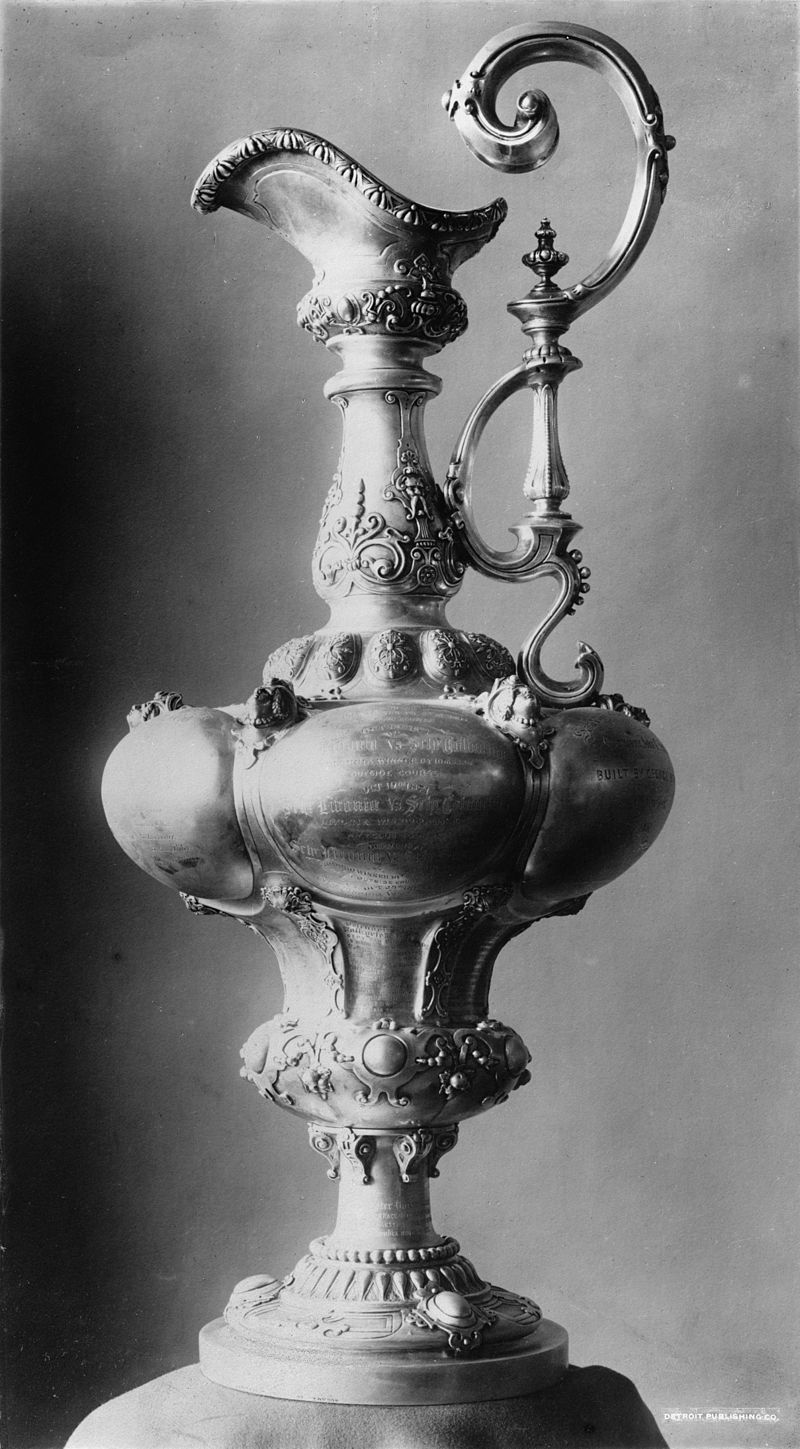
The America's Cup
The America's Cup, an illustration of which is given herewith, leaves much to be desired from an artistic point of view. It is not a Cup but a cylindrical vessel open at both ends, and incapable of holding liquid. This defect is not of serious importance in a prohibition country. Twenty-seven inches in height by 36 inches in circumference, and constructed of silver, it weighs 134 ounces. Although its intrinsic value is £100, it Is officially estimated that American yachtsmen, inclusive of the forthcoming contest, will have expended the sum of £1,000.000 in defending, while British yachtsmen in their 14 efforts to regain the historic trophy, have expended 1900,000.
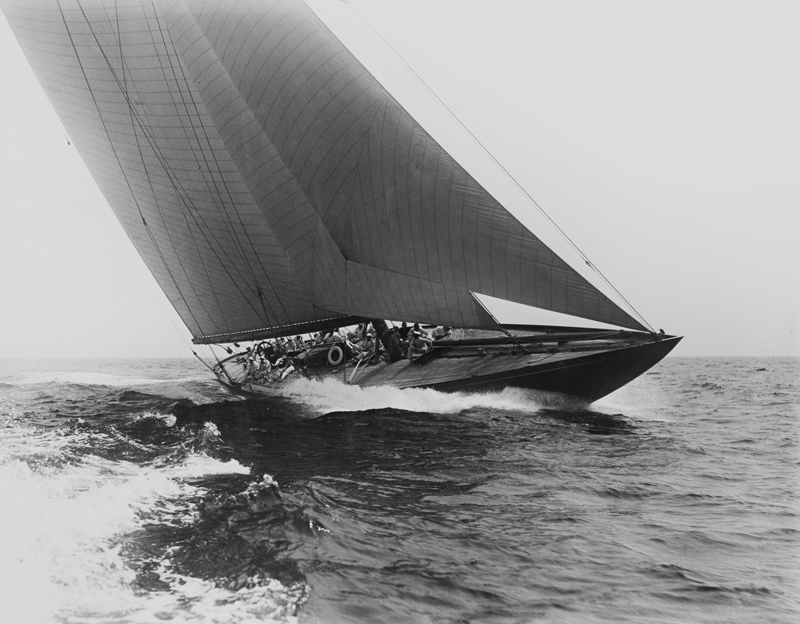
The Challenger, Sir Thomas Lipton's Shamrock V.
The Yachting Authority, JOHN ROCHE, Writes of (1930, September 12). Evening News (Sydney, NSW : 1869 - 1931), p. 6. Retrieved fromhttp://nla.gov.au/nla.news-article118765784
The Enterprise was a 1930 yacht of the J Class and the successful defender of the 1930 America's Cup. She was ordered by Harold Vanderbilt and designed by Starling Burgess. Enterprise was scrapped in 1935. She was one of many American vessels using the name.
What is also interesting about this 1930 edition of the America's Cup is that for the first time the Bermuda rig was used:
The America's Cup Race
Shamrock V.'s Challenge
THIS week yachtsmen all over the world are watching with interest the challenge races of Shamrock V. at Newport, U.S.A., against the defender, Enterprise, for the America's Cup. The conditions stipulate that the challenging yacht shall sail from where she is built to where the Cup is held, which is an initial handicap that has not yet been overcome since the schooner America took the Royal Yacht Squadron's Cup from England in 1851. Sir Thomas Lipton's efforts to lift the Cup are characteristic of British doggedness. His new boat, the present challenger, Shamrock V., represents the latest in science of yacht building and rigging. The last challenge races were in 1920, when Shamrock IV. was opposed by the Americans' Resolute. Shamrock IV. won the first of the series, the second was no race on account of a calm, and Resolute won the remaining three.
FOR the first time the builders were open with their designs. On previous occasions secrecy was observed in order to gain some advantage by the exercise of ingenuity in modelling or rigging. The builders of Shamrock V. and Enterprise examined and discussed plans. Both boats are built to Lloyd's A class, which means that both are sturdy sea-going craft, and there is no time allowance, first across the line being the winner of the heat. Also, for the first time the Cup is being raced for in the now popular rig known in England as the Bermuda, and here as the Marconi, which substitutes a tall, tapering mainsail (and corresponding headsails) for the old-time square mainsail with gaff and gaff-topsail. The new style does away with the bowsprit and long mainsail boom. The Cup ownership is to be decided on this occasion by winning four races out of seven, the first of which was sailed on Saturday, when the American boat won. Others are being sailed during this week.
SHAMROCK V., THE CHALLENGER.
ENTERPRISE , THE DEFENDER .
SIR THOMAS LIPTON. The America's Cup Race (1930, September 17). Sydney Mail (NSW : 1912 - 1938), p. 11. Retrieved fromhttp://nla.gov.au/nla.news-article159659047
A Bermuda rig, or Marconi rig is a configuration of mast and rigging for a type of sailboat and is the typical configuration for most modern sailboats too. This configuration was developed in Bermuda in the 17th century; the term Marconi a later reference to the inventor Guglielmo Marconi whose wireless radio masts resembled the wires that stabilize the mast of a Bermuda rigged ship. The rig consists of a triangular sail set aft of the mast with its head raised to the top of the mast; its luff runs down the mast and is normally attached to it for its entire length; its tack is attached at the base of the mast; its foot (in modern versions of the rig) controlled by a boom; and its clew attached to the aft end of the boom, which is controlled by its sheet.
Originally developed for smaller Bermudian vessels, and ultimately adapted to the larger, ocean-going Bermuda sloop, the Bermuda sail is set as the mainsail on the main mast. The Bermuda rigging has largely replaced the older gaff rigged fore-and-aft sails, except notably on schooners. The traditional design as developed in Bermuda features very tall, raked masts, a long bowsprit, and may or may not have a boom. In some configurations such as the Bermuda Fitted Dinghy vast areas of sail are achieved with this rig. Elsewhere, however, the design has omitted the bowsprit, and has otherwise become less extreme.
The 1914 trip wasn't the first time Walter Marks sailed with a Lipton Shamrock - one that seems to have afterwards been known simply as the 23 Shamrock, originally as a predecessor to a second Shamrock IV, was launched for a challenge that also didn't happen in 1908 - Sir Lipton continuing to build and launch her after the Challenge was turned down by the Americans in 1907 due to the Introduction of the International Rule.
A Sydney yachtsman
WALTER MARKS IN ENGLAND
Mr. Walter Marks, the well-known Sydney yachtsman, and owner of the Culwulla, who, with Mrs. Marks, is at present touring, England on a pleasure trip, writes from Penzance to Captain Mark Breach,. and says that he has written to Mr. Moore, the secretary of the Imperial Merchant Service Guild of Liverpool (Eng.), but that he did not know when he would get up/to see him. Mr. W. Marks is the Sydney representative of the Imperial Merchant Service Guild. He also states that he is motoring along the south and west coasts of England, and that he has already traversed some 800 miles amidst glorious scenery. Along the seaboard he saw many yachts, all of which, he says, are too big for Sydney. A visit was paid to the Franco-British Exhibition, where everything looks very fine, He further states that it is a pity that Captain Breach's patent ventilator Is not on view. He also sent a postcard of the Longships Lighthouse, a lighthouse, that is built on a pile of rocks at sea, and It shows the hermitage that the keeper is enforced into. A SYDNEY YACHTSMAN (1908, July 24).The Australian Star (Sydney, NSW : 1887 - 1909), p. 6 (FIRST EDITION). Retrieved from http://nla.gov.au/nla.news-article229091250
SIR THOMAS LIPTON'S FOURTH ATTEMPT TO "LIFT" THE CUP: THE LAUNCH OF SHAMROCK IV.
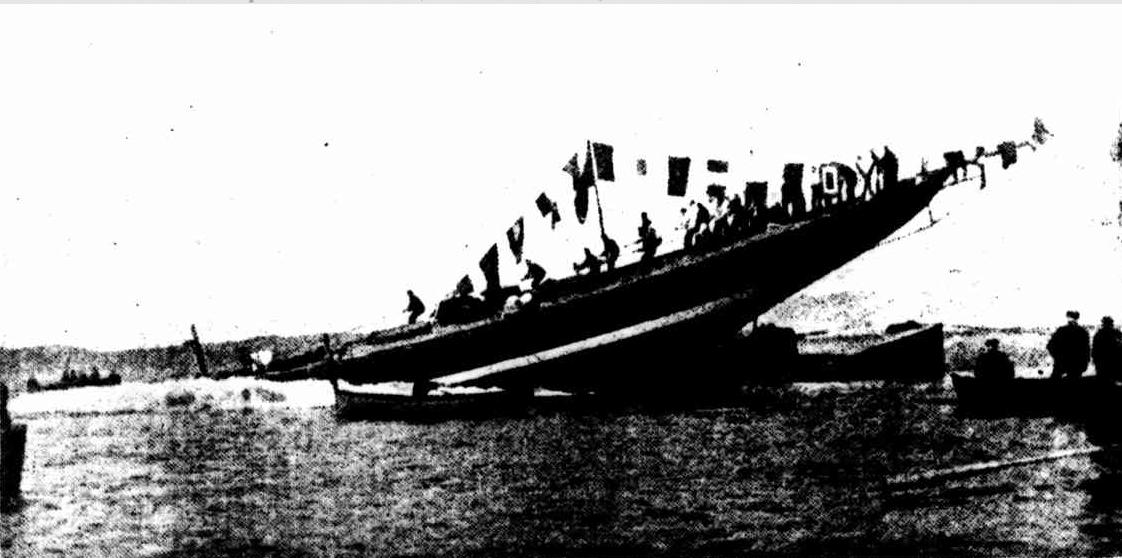
Sir Thomas Lipton has just launched on the Clyde his racing cutter, Shamrock IV. The name would seem to have a fascination for the worthy Baronet, for he has made three attempts to win the America Cup with yachts called the Shamrock, and it is said that the three vessels cost him in all more than £100,000. The new vessel was launched from a pontoon towed into deep water. ("Illustrated London News.") SIR THOMAS LIPTON'S FOURTH ATTEMPT TO "LIFT" THE CUP : THE LAUNCH OF SHAMROCK IV. (1908, June 2). Kalgoorlie Western Argus (WA : 1896 - 1916), p. 22. Retrieved from http://nla.gov.au/nla.news-article33277842
ENGLISH YACHTING.
SIR THOMAS LIPTON'S YACHTS.
A RACE ABOARD SHAMROCK IV.
(BY WALTER M. ' MARKS-"CULWULLA.")
As a representative Australian yachtsman and one who has had the good fortune to taste of the ripest fruits of the home season of 1908 I feel a sense of duty compels me to report myself to many friends in the yachting world of Port Jackson and to hundreds of others who take such on active part in this sport of kings and accordingly give them the benefit of what experiences I have had.
The season which has just close will always be memorable In that it was the means of introducing to the yachting public the new international rule-In other words the metro system under which 99 per cent of races for the next seven years will be sailed. This rule was adopted by England, France, Germany, Finland, Denmark, Holland, Belgium, Norway, Sweden, Italy, Spain, Switzerland, Austria, Hungary at a final conference of yachting experts held in Paris in October 1907 America was the only nation to stand out and mores the pity as It would have then given Great Britain as represented by that great
“trier” Sir Thomas Lipton a fighting chance instead of an absolute Impossibility as at present because the yachts built for this season under the metro rule are without doubt, a very fine wholesome type of boat especially so In the big class the 23 metres and such a boat as would make Ideal racing for the America Cup Instead of the huge freaks that have hitherto represented the two nations In that great contest...
Sir Thomas Lipton, Bt, K.V.C.O.
Whenever and wherever yachting is discussed one name always comes to the forefront at once and that Is Lipton, a household word among the lads the world over who are never content unless at the tiller or pulling a sheet or watching every move from the steamer, pier or parade. We all know of his repeated plucky trips across the pond with his great Shamrocks and the results but he never gives up hope-Instead his usual kindly smile brightens up his face and sparkles in his eyes and he says simply, “I’ll have another try”. And he will, if the Americans will only waive a trifle from the absurd and Impossible conditions that at present govern this contest. I have had the privilege of meeting many of the better class American on my travels and the majority admit that England has not got a sporting or a fighting chance under the present conditions Give Sir Thomas that chance which every sportsman has a right to demand and he will be In America every year until that little cup rests securely on the renowned and palatial Erin.
On my arrival in London I gladly accepted an invitation from Sir Thomas's secretary Mr Westwood to meet Sir Thomas at 6.30 p m one evening at his enormous offices in City road. On being ushered into his sanctum I was at once welcomed by “Very pleased to meet you Mr Marks. Now tell me all about yachting in Australia.” Etc.
In appearance he is quite six feet slim fair moustache and Imperial with face and hands well tanned from his racing on Shamrock IV during tho Irish and Clyde season from which he had just returned. On this and many subsequent occasions aboard the Erin and Shamrock IV when Sir Thomas was present I noticed that he was always the same bright jolly breezy Irishman and lacking possession of that one characteristic (side) which is so often met with in those “walking in high places” and this In a man who Is the acknowledged Intimate friend of that other great patron of yachting his Majesty the King
Before leaving I accepted his Invitation to join Shamrock IV., his latest 23 metre racing yacht from the yard of that celebrated designer W Fife of Fairlee Scotland at Deal on the English Channel on July 8 or 9 where she would be taking part in the regatta. I travelled by train to Deal a distance of 70 miles the evening before the regatta and ascertained at the hotel that the Erin and Shamrock had not arrived but next morning on looking out of bay window I observed away down the Channel near Dover’s glorious chalky cliffs an enormous white steam yacht with a sky scraping mast behind her. It turned out to be the Erin towing the Shamrock IV up to Deal in weather which could not by any means be called soda and milk as It was blowing hard from the south est with a fair roll close ...
Shamrock IV
Before describing our sail off Deal a description of Shamrock herself seems necessary. As before pointed out she is a 23 metre yacht designed and built by W Fife in his yard Fairlie on the Firth of Clyde Scotland for the present season. In Thames measurement her tonnage is 170 tons, length 96 feet beam 21 feet depth 11 feet. She has, of course, the usual overhangs fore and aft, always associated with these modern greyhounds but they are by no moans extreme and this beautiful shapely hull painted as it is in a light green with perfect white decks, varnished deck fittings and an enormous spread of white canvas is a sight never to be forgotten. She is steered by a wheel instead of the usual tiller as are also all her class boats-somewhat of an Innovation on this side although In America it has been the custom for years past. Having seen the Shamrock In a gale with the wheel It surprised me how they managed to control the huge ships of a few seasons back by means of the tiller and lanyard. A surprise was in store for me on going below where I found she was fitted out In a most luxurious fashion into a large main dining saloon, several large staterooms, bathroom, pantry, servery, kitchen, and forward in the forecastle 22 cots were suspended the whole filled with electric light, carpets on the floors, the woodwork of highly polished satin and other decorative woods-and this on a modern racing yacht....
ENGLISH YACHTING. (1908, December 26). The Sydney Morning Herald (NSW : 1842 - 1954), p. 11. Retrieved from http://nla.gov.au/nla.news-article15025231
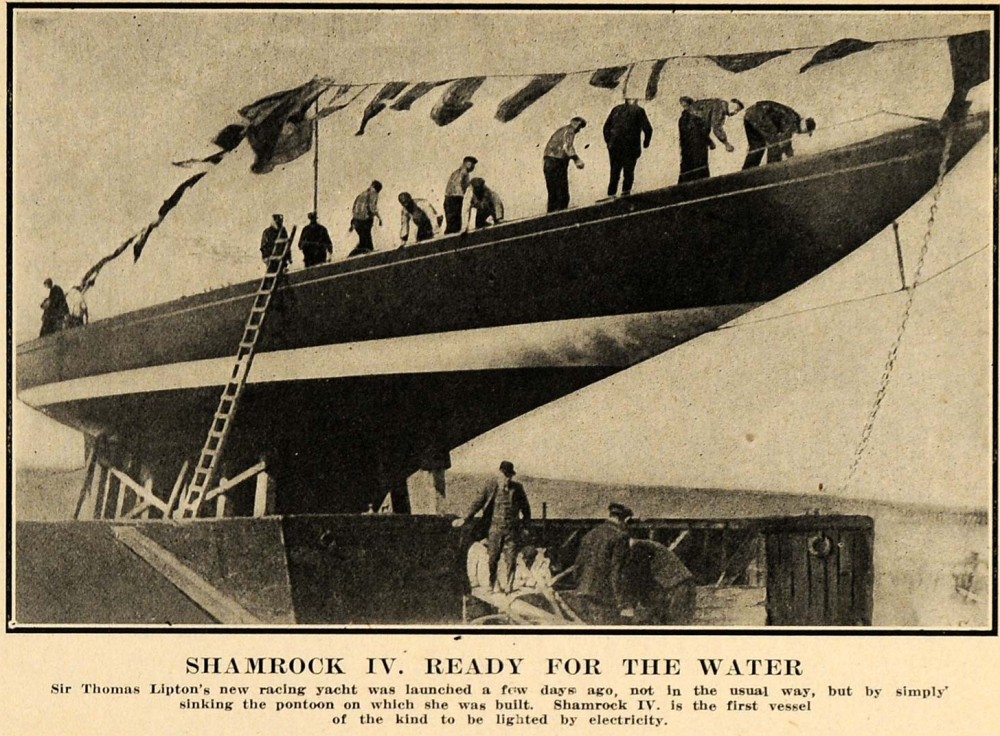
Another newspaper clipping from 1908 of the first Shamrock IV
Walter Moffitt Marks (6 June 1875 – 31 March 1951) was an Australian lawyer, yachtsman and politician. Born in Culwulla House, Jamberoo, New South Wales and educated at Sydney Grammar School. He was admitted as a solicitor in 1902. In September 1901 he married Florence Sandford. As a result of an inheritance in 1912, he was able to partly finance the building of his chambers, the twelve-storey Culwulla Chambers in Castlereagh Street, Sydney, the tallest building in central Sydney until after World War II.
The Culwulla Chambers, still extant, was the first Sydney 'skyscraper':
SYDNEY AS VIEWED FROM A SKYSCRAPER.
A TALL BUILDING.
LORD MAYOR LAYS COPING-STONE.
SHOULD SYDNEY HAVE SKYSCRAPERS
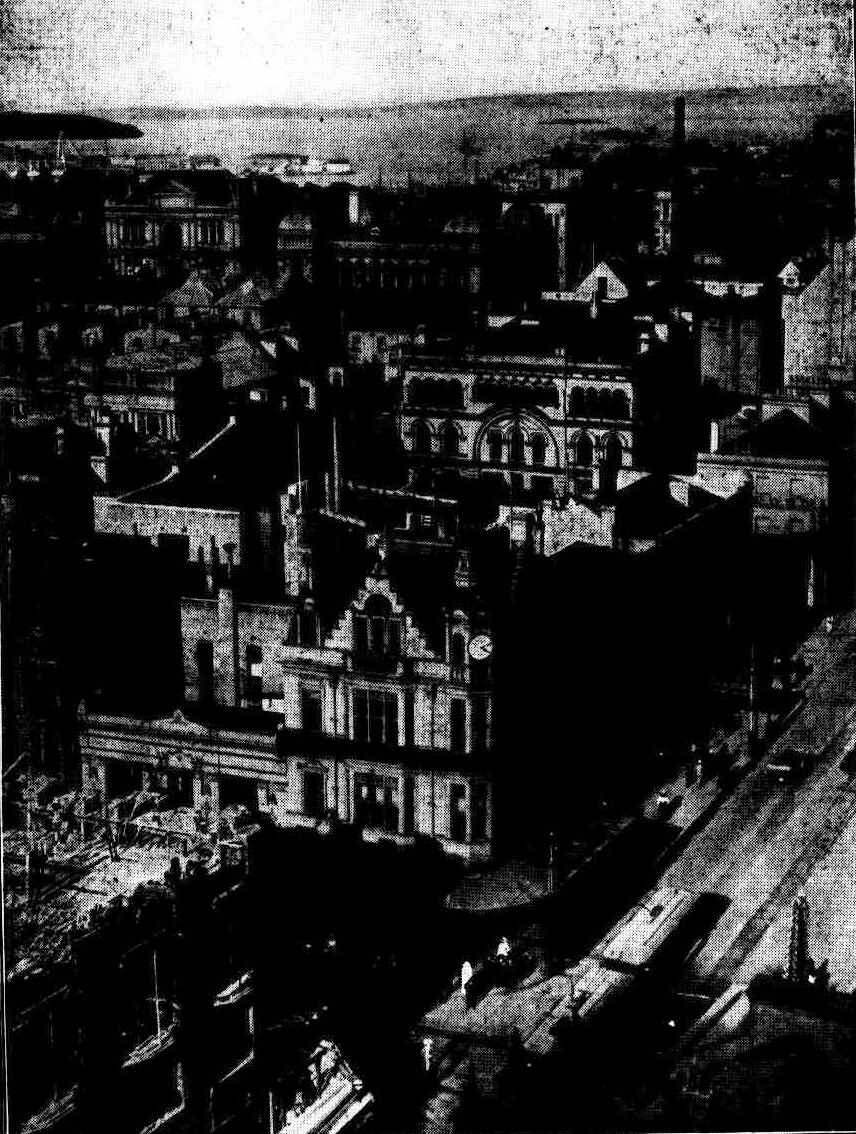
The photograph presented herewith was taken yesterday afternoon from the top of Culwalla-chambers, the most elevated building in Sydney, near the intersection of King and Castlereagh streets.
The Lord Mayor, Alderman G. T. Clarke, laid the coping-stone of Culwulla-chambers yesterday afternoon. The new building is almost immediately at the corner of King-street and Castlereagh-street. The huge red pile has already climbed 11 stories high, and its elevation facing King-street is 165ft from the pavement. So far it comprises 1,853,000 bricks, 500 tons of steel, besides a large quantity of concrete. It will have cost about £100,000 when ready for occupation—probably in April next year. The builders are Robert Wall and Sons, and the architects Spain, Cosh, and Minnett. The persons responsible for the erection are the trustees of the late Sarah Jane Marks.
The scene yesterday on the summit of the building was very interesting. A magnificent view was obtained of the city, the harbour, and surrounding country. Plainly the rolling of the Pacific could be seen outside the Heads and Darling Harbour appeared to be nothing more than a miniature lake.
Mr Walter M. Marks laid a coping-stone, and the Lord Major the last of all to be laid in the building.
The Lord Mayor said he understood the building would be fireproof. Well, that got over one of the difficulties raised by those who opposed the erection of high buildings. He asked whether Sydney's streets lent them-selves to the erection of tall buildings or sky-scrapers'. This building was not so high as it had been reported to be and was not a sky-scraper in any sense of the word when compared with the Walworth-buildings, New York, which was 775ft high. Regarding the right of persons to construct those high buildings, he was against the idea that the Legislature of the country should regulate heights of buildings by an Act of Parliament. He favoured the idea of leaving the decision in the hands of the people. (Applause. ) As soon as an Act of Parliament was passed to control the heights of buildings so soon would Sydney have to say "good-bye" to enterprise of any shape or form. This was a municipal question, and should be left in the hands of the people to deal with municipally from time to time. (Applause. ) He was sorry that our streets were so narrow, and the question was could we begin to in-crease the width of them? He had yet to learn that streets like Market-street, George-street, and Pitt-street would not be widened in time to come. And if such were the case Sydney did not want to be hampered by an Act of Parliament which would not, perhaps, act in the best interests of the community. The City Council said the heights of buildings should not exceed 150ft. (Cries of "Shame," and cheers ) The Lord Mayor felt sure the persons who had constructed this building would not be taxed for the building, but only for the value of the land upon which it stood, otherwise other persons with enterprise would not be keen on removing old properties for properties of a palatial character. (Loud
applause. )
Mr. Watkin Wynne proposed the health of "The Architects and Builders;" and Mr Spain, for the architects, and Mr T. Wall, for the builders, responded. SYDNEY AS VIEWED FROM A SKYSCRAPER. (1912, October 18). The Sydney Morning Herald (NSW : 1842 - 1954), p. 12. Retrieved fromhttp://nla.gov.au/nla.news-article15368245
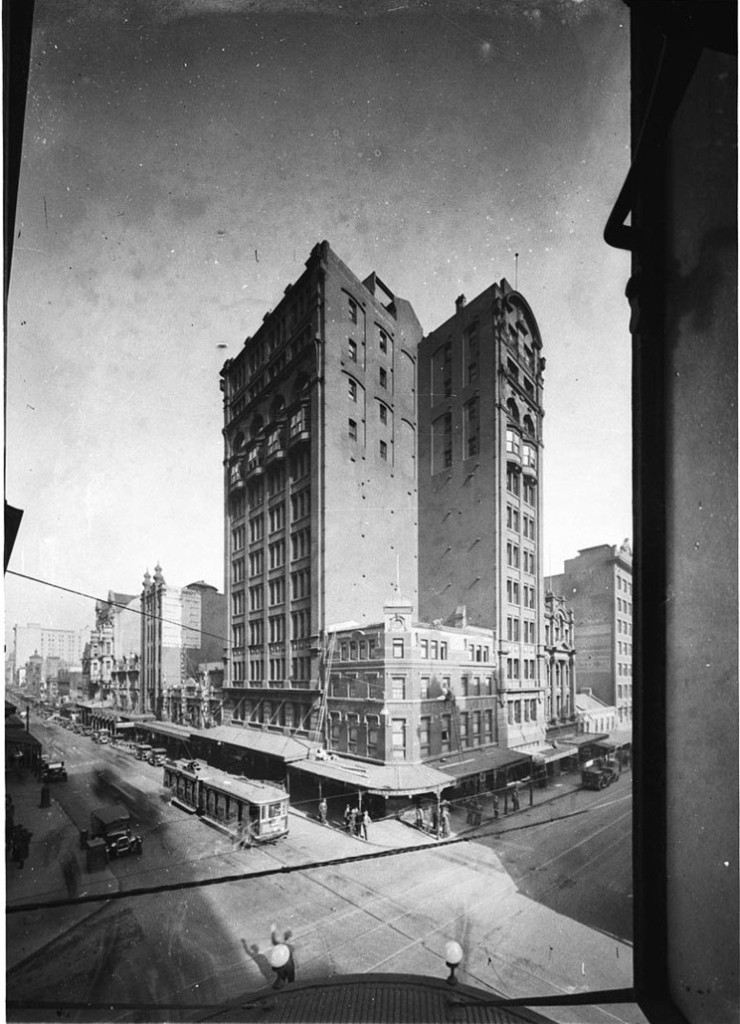
Culwulla Chambers (Sydney, N.S.W.) Corner King & Castlereagh Streets, 1918-1932. Photo by Hall & Co. Album: Hall Collection : photographs of Sydney streets, buildings and people, 1900s-1930s, courtesy State Library of NSW, Home and Away - 34761
Mr. Marks won most major Australian yachting trophies in Culwulla I-IV, and participated in the trials of Sir Thomas Lipton's America's Cup challenger, Shamrock IV in 1914. In World War I he joined the Royal Navy Volunteer Reserve and served as a lieutenant in the North Sea and English Channel, commanded a gunnery school in Wales and returned to Australia in 1918 to encourage military recruitment.
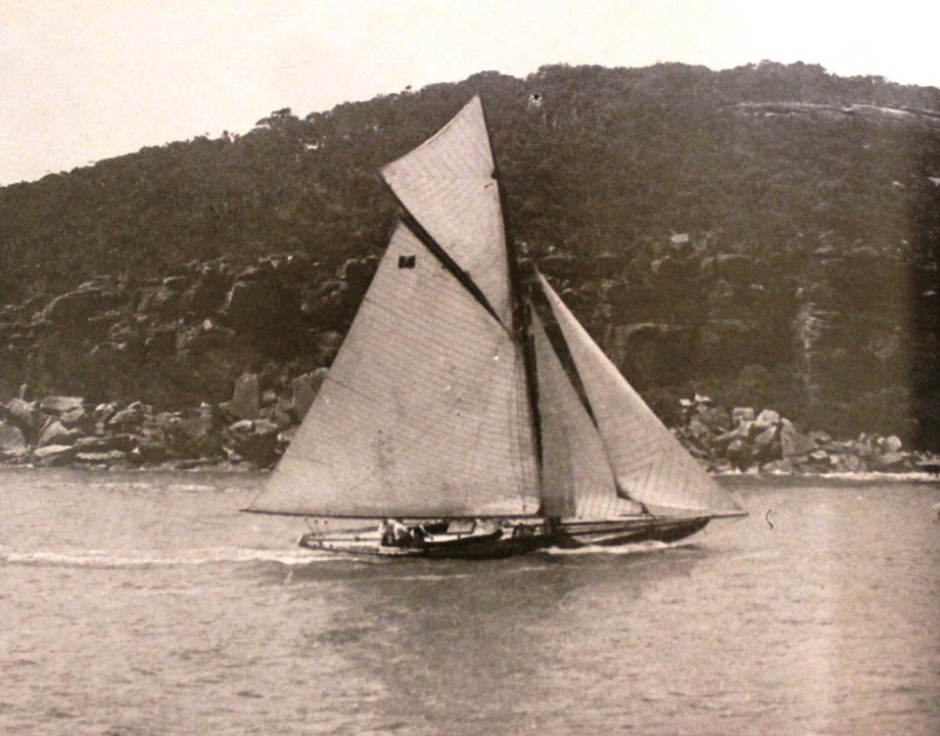
Walter Mark's Culwulla III pictured rounding Lion Island in 1914: MR. W. M. MARKS' CULWULLA III.
Designed by W. Fife, of Fairlie, Scotland ; builder, W. Ford, jun., Sydney, 1907. Length over-all, 50ft. l.w.l., 30ft., beam, 9ft. 3in.; tons, 13. MR. W. M. MARKS' CULWULLA III. (1910, February 22). The Mercury (Hobart, Tas. : 1860 - 1954), p. 5. Retrieved from http://nla.gov.au/nla.news-article10054129
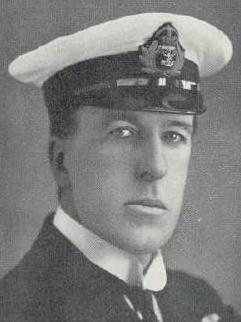 Marks was elected as a Nationalist member for the seat of Wentworth in 1919. He made a notorious speech predicting that Armageddon would be initiated in 1934 when the British navy collected the Jewish people to take them to a Palestine.
Marks was elected as a Nationalist member for the seat of Wentworth in 1919. He made a notorious speech predicting that Armageddon would be initiated in 1934 when the British navy collected the Jewish people to take them to a Palestine. Billy Hughes made him honorary under-secretary "to assist the prime minister especially in the administration of the mandated territories and shipping" in December 1921 in order to head off pressure to appoint him Minister for the Navy, but Stanley Bruce abolished this position in 1923.
He took a strong interest in foreign affairs, aviation and the film industry. He was one of seven Nationalists, including Billy Hughes, who voted to bring down the Bruce government, forcing the 1929 election. Although he lost Nationalist Party endorsement, he won the election.
He was defeated at the 1931 election by Eric Harrison, although both had United Australia Party endorsement. Marks died following surgery in the Sydney suburb of Paddington, survived by a son and a daughter.
During World War II he took a vigorous part in recruiting and victory loan campaigns.
Commodore of the Royal Prince Alfred Yacht Club for seven years, he was a member of the Royal Sydney Yacht Squadron, the Sydney Amateur Sailing Club and the Royal Sydney Golf Club. In his later years he led several State bowling teams.
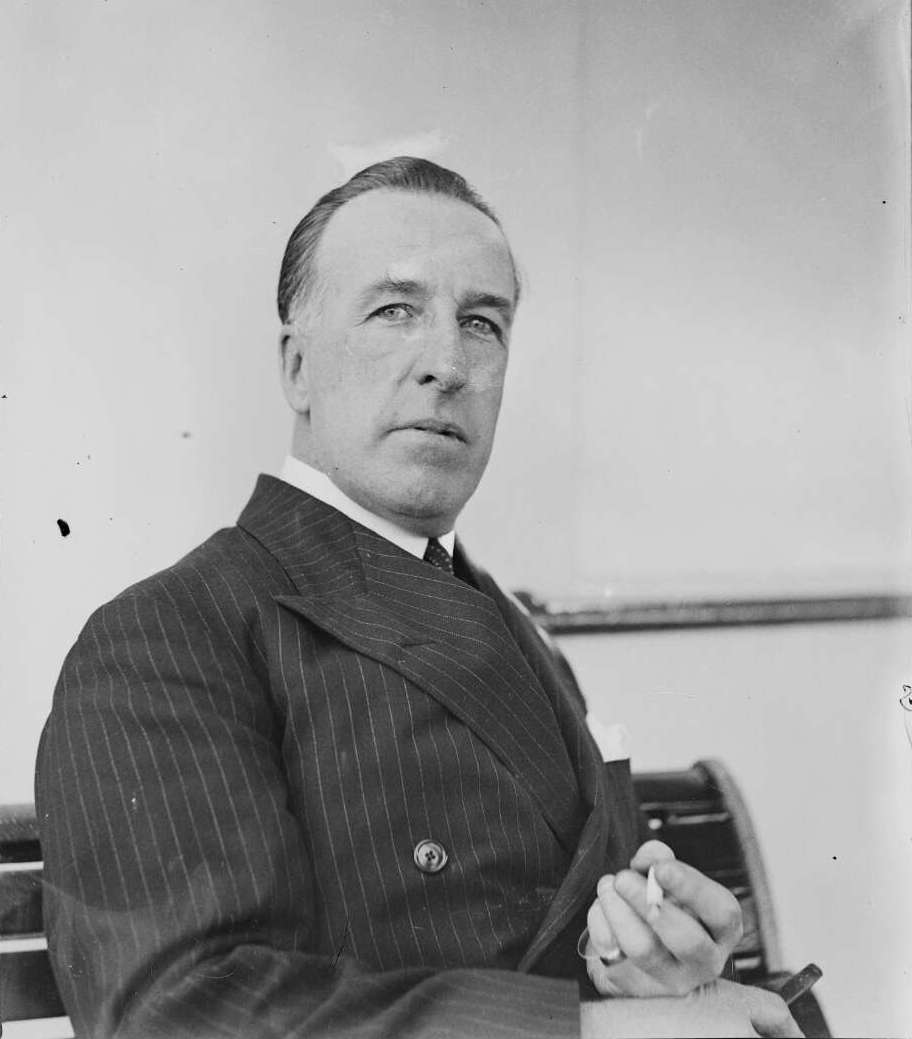
Mr Walter Marks, Member of the House of Representatives, New South Wales, ca. 1930. http://nla.gov.au/nla.obj-160488798, courtesy National Library of Australia.
Former M.P. Dies At Age Of 76
A former Federal Parliamentarian, Mr. Walter M. Marks, of Woollahra, died yesterday after a short illness. He was 76. He was Nationalist member for Wentworth from 1919 to 1931, and Parliamentary Under-Secretary for External Affairs from 1921 to 1923. Mr. Marks was a solicitor for 48 years. He was a commander in the R.A.N. from 1915 to 1919, and was chief voluntary speaker for the recruiting campaign last year.
YACHT SUCCESSES
His yachts Culwulla I and Culwulla II won many State and interstate championships. He also led 16 New South Wales bowls teams m Tests against Queensland and Victoria. He is survived by a son, Commander W. Marks, R.A.N,. and a daughter, Mrs. Peter Sloane, of Woollahra. Commander Marks is the captain of H.M.A.S. Bataan. Mr. Marks will be given a State funeral. It will leave All Saints' Church, Woollahra, at 2.30 p.m. on Tuesday. Former M.P. Dies At Age Of 76 (1951, April 1). The Sunday Herald (Sydney, NSW : 1949 - 1953), p. 4. Retrieved from http://nla.gov.au/nla.news-article18486554
BIG YACHTING.
MR. W. MARKS IN ENGLAND. DESCRIBES THE SHAMROCK.
A cable from Mr. Walter M. Marks, of the Royal Prince Alfred Yacht Club, Sydney, received this morning by Messrs Marshall and Marks, Culwulla Chambers, City, Indicates that the Sydney yachtsman is having a good time, in the United Kingdom. He states that he is at present the guest of Sir Thomas Lipton on board the steam yacht Erin at Southampton, and will represent Australia at the official launch of the Shamrock IV., challenger for the America Cup. today (Tuesday). The cable adds: 'I have had a private Inspection of the challenger, and can say that she is a novel and wonderful creation.'
According to Mr. Marks, the Interest In England between the Shamrock and a defender not yet decided upon, is intense. It may be stated that in response to a cable from a number of his trlenaa in the Royal Prince Alfred Yacht Club, requesting him to allow himself to be nominated for the office of commodore of the Royal Prince Alfreds at Sydney. Mr. Marks has baa wired an answer in the affirmative. No opposition Is likely, so that it is expected Australia's representative at the America Cup races will succeed Mr Norman H. Murray, R.Y.S.
Mr. Marks has been an advocate of the Hobart one-class one-design type of yacht, and it was mainly due to his efforts, in conjunction with Mr. S. M. Dempster. that the class was decided upon by the Royal Prince Alfreds. And to show his consistency over this matter, he bought the Curlew, the pioneer of the class In Sydney. There is, however, at present some doubt as to whether the boats will appear at Sydney during the 1914-15 season. As was the case with the 8-metre type, the question of price has cropped up. BIG YACHTING. (1914, May 26). Evening News (Sydney, NSW : 1869 - 1931), p. 6. Retrieved from http://nla.gov.au/nla.news-article114340327
UPTONS CHALLENGER.
WALTER MARKS NOT IN CREW PROFESSIONAL JEALOUSY.
(From Our Special Representative,).
LONDON; Tuesday Morning.
Mr. Walter Marks,- of Sydney, is on board Sir Thomas Lipton's challenging yacht -Shamrock IV., and will help to sail her in her trials, lasting over a period of three weeks. He will not, however, take part in the race for the America Cup, as it is feared that his presence in the crew might excite Jealousy among the professionals and cause discord. When the .Shamrock sails across to Sandy Hook he will go in the Erin, which will accompany the challenger; and during the races he will also be aboard the Erin. Mr. Walter M. Marks is well known as a Sydney yachtsman, and is commodore of the Royal Prince Alfred Yacht Club and owner of the racer Curlew. He formerly owned Culwulla III. He went to England in response to an invitation to be a member of the crew of the Shamrock, and, no doubt, he is greatly disappointed at the decision that has been arrived at. It is not, however, altogether a surprising decision, as in the past there has always been jealousy displayed when amateurs have tried to get into the greatest yacht race of all, and no doubt Mr. Marks has, in sportsmanlike fashion, agreed to a request to stand down. LIPTON'S CHALLENGER. (1914, July 14). The Sun (Sydney, NSW : 1910 - 1954), p. 8 (FINAL EXTRA). Retrieved from http://nla.gov.au/nla.news-article229854441
GATHERING AT THE LAUNCHING OF .SHAMROCK IV. AT GOSPORT-THE CEREMONY WAS PERFORMED BY THE COUNTESS OF SHAFTESBURY.
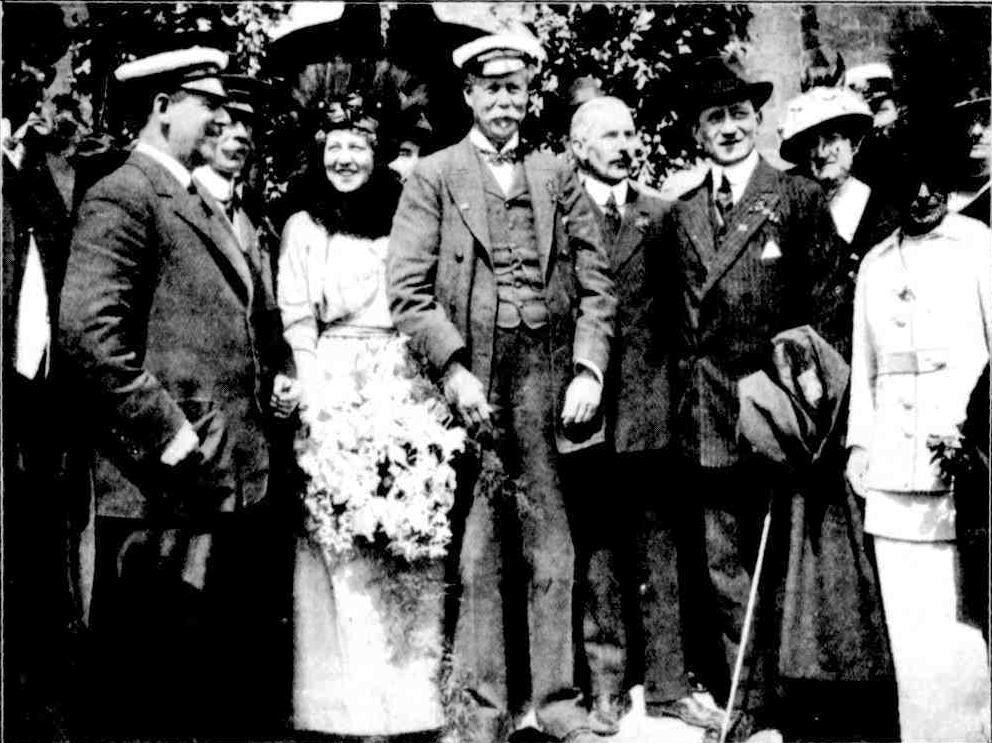
Left to right: Col. Neill, Mr. W. P. Hutton (who will sail the yacht) the Countess of Shaftesbury, Sir Thomas Lipton, Mr. C. Nicholson (the designer). Mr. Marconi, and Lady Henry. GATHERING AT THE LAUNCHING OF SHAMROCK IV. AT GOSPORT—THE CEREMONY WAS PERFORMED BY THE COUNTESS OF SHAFTESBURY. (1914, July 3). Western Mail (Perth, WA : 1885 - 1954), p. 24. Retrieved from http://nla.gov.au/nla.news-article37973482
ENGLISH CHALLENGER FOR THE AMERICA CUP.
SIR THOMAS UPTON'S SHAMROCK IV. BEING LAUNCHED AT GOSPORT.
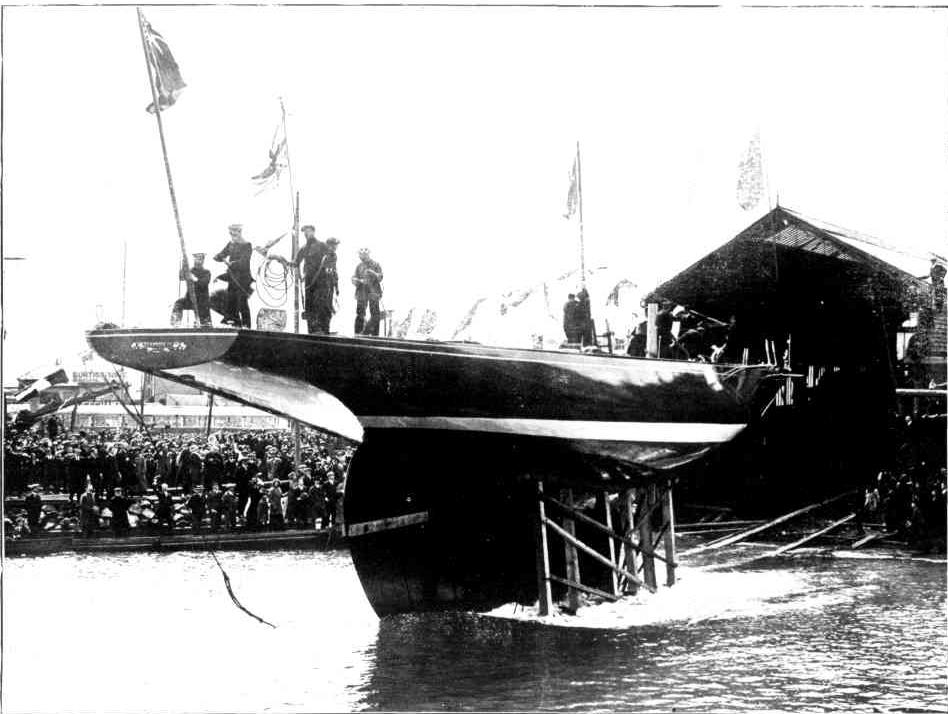
ENGLISH CHALLENGER FOR THE AMERICA CUP. (1914, July 4). Observer (Adelaide, SA : 1905 - 1931), p. 63. Retrieved fromhttp://nla.gov.au/nla.news-article163132980
The Launch of Shamrock IV.
THERE was an unwonted stir on Tuesday, May 26, in the quaint little town which at one time boasted the glorious title of God's Port, but which in a less reverent age is known as Gosport.
For a hundred years Gosport has been famous for its yachts and yachtsmen. One firm created ; the industry, and the same firm continues to this day. The yacht-building yards were established by the late Mr. Benjamin Nicholson, and his son Charles is the creator of Sir Thomas Up-ton's latest challenger for the America Cup, Shamrock IV. Little wonder that Gosport should don holiday attire in honor of the launch day.
LIKE A GREEN BOTTLE. A hundred journalists had travelled from Lon-don in a special shamrock-bedecked express. All eyes and all attentions were for the won-derful green yacht which lay naked and ready for the water, with her topsides sleek and shining as a beautiful green bottle. Telegrams and cables announced her launch to all corners of the globe.
Yet what must the ordinary spectator have thought about her? Not so wonderful, perhaps —not so marvellous. To him she was just a boat, and an odd-looking one at that. The peculiar round of her topsides (called "tumble-home" by sailormen) would pass unquestioned; the swollen bow would have no meanings for him; the hollow near the bobstay bolt would never be noticed, and the long, heavy stern would perhaps appear to him as something clumsy.
Under water, the long-easy floor, the deep, thick keel, would express nothing of the de-
signer's mind. 'Yet these and a hundred other points are full of the greatest interest. Each
curve, each line, each almost imperceptible fullness or hollow, was carefully considered be-fore it appeared as it did yesterday.
To the yachtsman several features were evident, and the first, that Mr. Nicholson had designed what is technically known as a "big bait," and one which could and would have to carry enormous sail. There can be no doubt about this latter, for the main stick of the mast was promptly put in place after the launch and cannot have been much less than 120ft. in length, though a bare 7ft. of that, was "in the yacht"; that is between the deck and the stem on which it was stepped.
A MAST IN PIECES.
This enormous .spar is built of innumerable pieces of fine silver spruce. It was so care-fully jointed that only close examination could detect the system whereon it was built. In days not so long gone a good stout Oregon tree was dressed and put in place to serve as a mast.
Then came hollow spars of steel, and then hollow and built masts of silver spruce—wonder-fully light; wonderfully strong, and most expensive. That long, bare stick standing in Shamrock IV. would probably cost over £600. And as one unexpected puff of wind would put it over the side, two masts are already built. From this it may be gathered that racing for the America Cup, is not a poor man's recreation.
But to return to the yacht as we first saw her (says the special correspondent of the "Daily Mail"). She is a much more remarkable boat than any built in the United States, and the long, heavy counter and the pudding-ended bow will give her an extraordinary sailing
length, so that, although she may measure 75ft. on the waterline when upright, immediately the wind pressure heels her, the sailing length will be enormously increased, all of which goes for stability and speed.
To cope with the great hoist of sail, the rigging is taken outboard. Two huge outriggers stand out on either side, perhaps three feet or little less, to take the end of the shrouds at the deck. So short is the bowsprit that it appears but a stump, but the fact will be appreciated that this large racing yacht will carry only one headsail; the first yacht of any size to do on this side of the Atlantic, and probably the largest yacht to do so anywhere.
Throughout the boat simplicity is the most noticeable feature. Nothing that can be dispensed with is included. The deck is bare, save for the few necessary cleats and leads. A little cockpit contains the neat steering gear, connected with a quadrant working the rudder below deck, where, excepting one or two light partitions, there is nothing from one end of the boat to the other; nothing but a series of girders, struts, and beams, bewildering to the uninitiated, but full of interest to those conversant with the building of such craft.
VICTORY SALUTE COINCIDENCE.
All this might have been noted by the spectator before, at noon, the old Victory, lying a few cables off, roared forth a Royal salute in honor of her Majesty's birthday. Almost simultaneously the Countess of Shaftesbury christened the yacht, willing hammers struck at the wedges supporting the hull, and one swinging blow dislodged the dog-shore which kept one sliding way upon the other. With champagne dripping from her bows, the new yacht glided from her birthplace. Gathering way, she shot from the open end of the building shed towards the blue waters of Portsmouth Harbor. Amid ringing cheers she gracefully crossed the shore, and with a gentle lurch pitched over the beach bank and lay waterborne before the cheering thousands, a long, green hull upon which the sun shone with apparent good-will.
It was immediately evident that the designer had calculated well. Only naval architects are conversant with the difficulty of making such a yacht float at a proper level and with a proper draught, A slight miscalculation, and immense bother and expense would be incurred to alter the trim of such a boat, weighted as she is with a concentrated, homogeneous mass of lead. She must float at a certain draught, and she must float at a given trim. Evidently, there was no mistake in the Shamrock's design, so far as displacement and allocation of weights were concerned.
Certainly if a good beginning counts for any-thing, Shamrock of the four leaves has had it.
CARGO OF MASCOTS.
In response to the toast of his health at the luncheon which followed the launch, Sir Thomas Lipton said very many people had a great belief in mascots, and when he last at-
tempted to "lift the cup" he had 23 horseshoes, including one from Fitzsimmons, the champion boxer. He also got tiger's whiskers, a green hen partridge, pedigree rabbits, frog's legs, chicken's wishbones, grasshoppers with legs like dromedaries', and a magnificent American eagle; in fact, his yacht was like a menagerie. A lady wrote to him wishing him to take her son, who was a young man with beautiful red hair. This offer, and also one of an elephant, he had to refuse.
This year he had had a monkey given him by Sir Thomas Dewar, but the mascot he was relying on was a four-leaved shamrock.
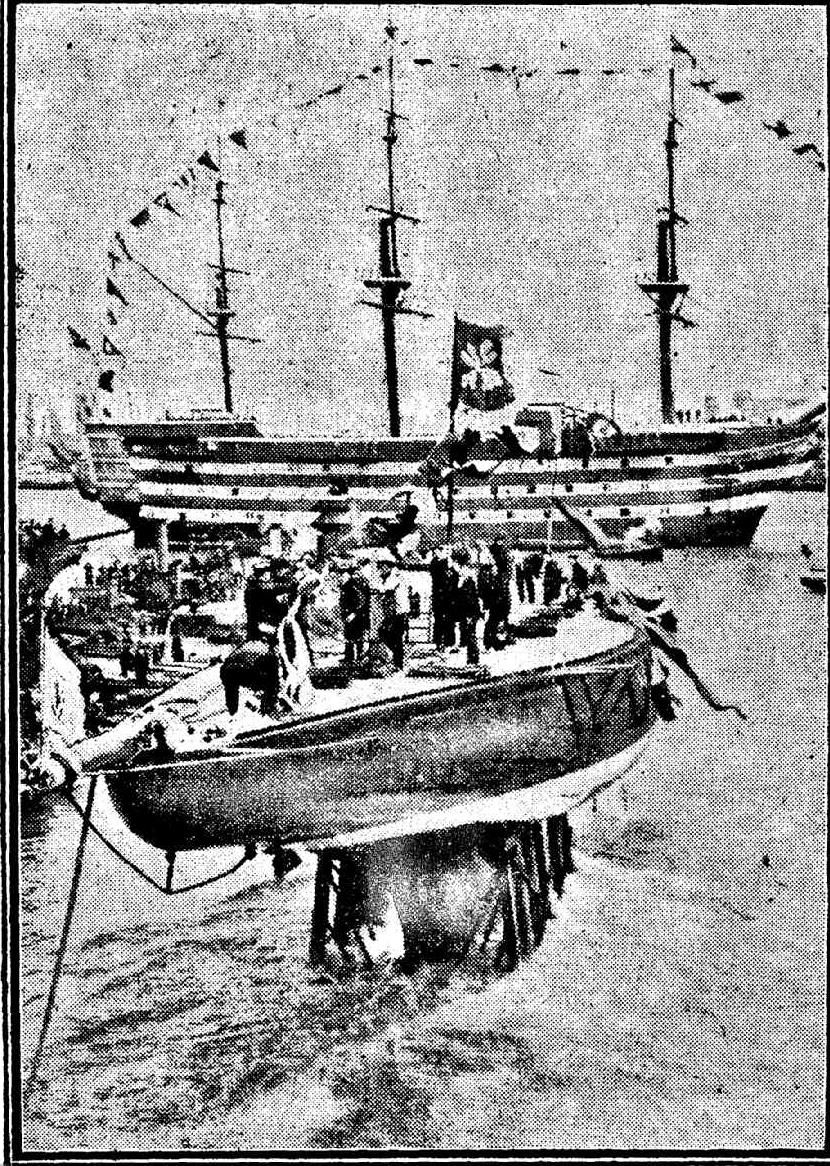
Shamrock IV., America Cup Challenger leaving the slips whilst the Victory, fired a Royal salute.
The Launch of Shamrock IV. (1914, July 4). The World's News (Sydney, NSW : 1901 - 1955), p. 12. Retrieved from http://nla.gov.au/nla.news-article131499947
Commodore Marks was invited back for the first post WWI Shamrock Challenge but could not attend due to commitments here.
The other great aspect of this 1930's report and the Shamrock V is that she is still out there -
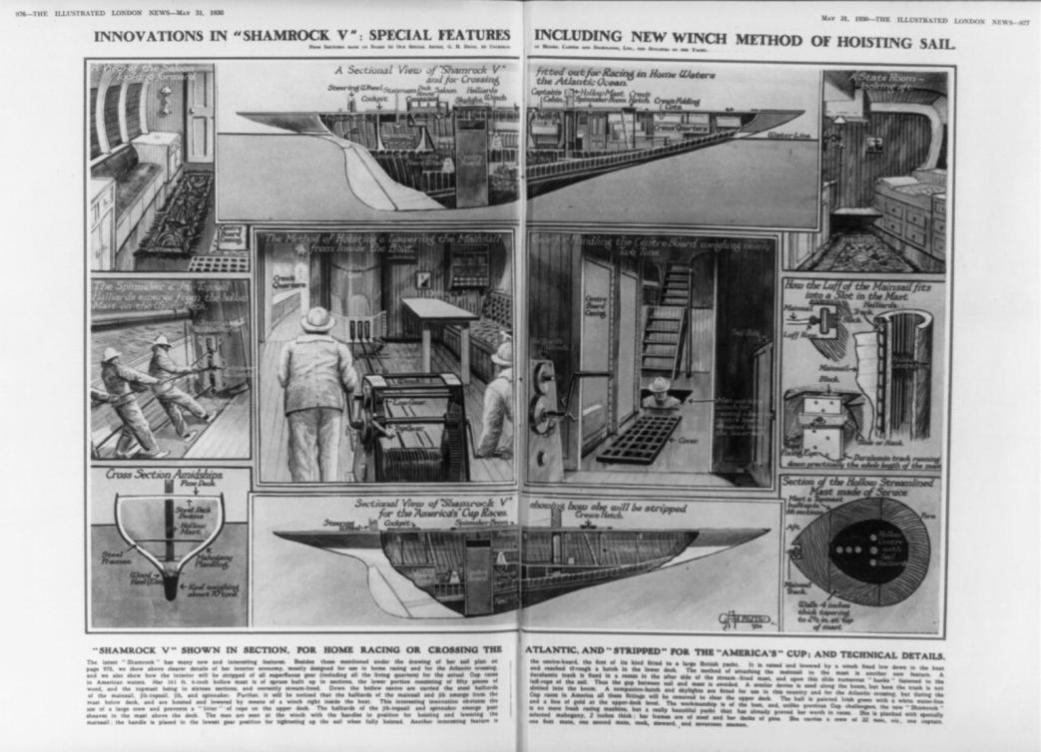
Innovations in "Shamrock V" ... including new winch method of hoisting sail - 1930, 1 print : wood engraving. Illus. in: The Illustrated London News, 1930 May 31, p. 976-977. Courtesy Library of Congress Prints and Photographs Division Washington, D.C. - http://www.loc.gov/pictures/item/2003663571/
Shamrock V was the first British yacht to be built to the new J-Class rule. She was commissioned by Sir Thomas Lipton for his fifth (and ultimately last) America's Cup challenge. Although restored many times she is the only J-class never to have fallen into dereliction.
The services of Charles Ernest Nicholson were once again employed to design the challenger and she was constructed at the Camper and Nicholsons yard in Gosport. Shamrock V was built from wood, with mahogany planking over steel frames and, most significantly, a hollow spruce mast. As a result of rule changes, she was the first British contender for the America's Cup to carry the Bermuda rig. Following her launch on 14 April 1930 she showed early promise on the British Regatta circuit winning 15 of 22 races. She also underwent continuous upgrading with changes to her hull shape, rudder, and modifications to the rig to create a more effective racing sail plan before departing to America in time for the 15th America's Cup.
Four New York syndicates responded to Lipton's challenge each creating a J-Class, Weetamoe, Yankee, Whirlwind, and Enterprise. This was a remarkable response particularly during depression-hit America with each yacht costing at least half a million dollars; and would serve to highlight that despite the J-Class' immense power and beauty, their Achilles heel would be the exorbitant cost to construct and race them. Winthrop Aldrick's syndicate, Enterprise, emerged from the competitive round-robins as the eventual defender.
Enterprise was the smallest J-Class to be built, her size being an early indication of the ruthless efficiency that was employed by the renowned naval architect Starling Burgess. The efficiency of design was coupled to a number of pioneering features such as the Park Avenue Boom, hidden lightweight winches and the world’s first duralumin mast.
The first of the best-of-seven races was a convincing victory for Enterprise winning by nearly three minutes. Shamrock V was to fare worse in the second race losing by nearly 10 minutes. The third race finally provided the assembled thousands on the shore at Newport, the racing they craved. Shamrock V's initial lead at the start was relinquished to Enterprise after a tacking duel. Following this surrender disaster struck, as Shamrock V's main halyard parted and her sail collapsed to the deck. The fourth race clinched the cup for Enterprise after which Sir Thomas Lipton was heard to utter "I can't win".
Shamrock V's challenge was plagued by bad luck and haunted by one of the most ruthless skippers in America's Cup history, Harold Vanderbilt. Sir Thomas Lipton, after endearing himself to the American public during 31 years and five attempts, would die the following year never fulfilling his ambition to win the cup.
The British aviation industrialist Sir Thomas Sopwith was to be the next custodian of Shamrock V. Already a keen yachtsman, Sopwith bought her in 1931 as a trial horse to gain J-Class racing experience. He would also add to Nicholson's skills with his own aeronautical expertise and material knowledge to build and perfect his challenger for the 16th America's cup, Endeavour.
Shamrock V was then sold to Sopwith's aviation friend, and fellow yachtsman, Sir Richard Fairey of Fairey Aviation who continued to incorporate aerodynamic and hydrodynamic modifications as well as campaigning her against other J-Class yachts (Velsheda, Endeavour, and Yankee) during the 1935 regatta season. In 1937, Shamrock V was sold to the Italian senator and industrialist Mario Crespi. This change in ownership prompted Shamrock V's only name change. Italian Fascist law had banned the use of foreign names in society, accordingly Shamrock V was renamed Quadrifoglio (cloverleaf). Crespi was also the first owner who modified Shamrock V for comfort by installing her maple interior.
A renaissance for Shamrock V began in 1962 with her acquisition by the Italian yachtsman Piero Scanu. He instigated a comprehensive three year overhaul commencing in 1967 with Shamrock V returning to the Camper and Nicholsons yard. The hull and deck received significant attention along with the modernisation of the systems and engines. The effects of this rebuild were to last the next twenty years during which a remarkable repeat of history was enacted when, in 1986, Shamrock V returned to the ownership of the Lipton Tea Company who donated her to the Museum of Yachting at Newport, Rhode Island. Another extensive restoration was instigated by her new owners and undertaken by Elizabeth Meyer in 1989.
Following changes of ownership in the 1990s and another renovation, Shamrock V participated in a fitting reunion in August 2001 with the only two remaining J-Classes, Endeavour, and Velsheda, for the America's Cup Jubilee in the Solent. In March 2016 it was reported that Shamrock V had changed ownership; she had been listed for sale with an asking price of €6 million.
Visit: shamrockv.com
Shamrock V. (2017, February 27). In Wikipedia, The Free Encyclopedia. Retrieved from https://en.wikipedia.org/w/index.php?title=Shamrock_V&oldid=767691496
The 1851 Beginnings Of A Great Sailing Race
The 100 Guineas Cup or Hundred Guinea Cup (£100 Cup) regatta of 1851 was the first competition for the America's Cup trophy. Originally, Cup of One Hundred Sovereigns, the value of the trophy was 100 pounds-sterling, hence its names, variations on 100 Pound Cup. The race was won by the yacht America, leading to the trophy being renamed "America's Cup". The 1851 competition was the first to compete for the trophy, hence the 1851 America's Cup or 0th America's Cup being zeroth, sequentially preceding the first America's Cup of 1870. The event "The America's Cup" would not be founded until 1857, when the deed of gift established the America's Cup racing regattas. The 1851 edition was a fleet race, unlike modern America's Cups finals, which are currently match races.
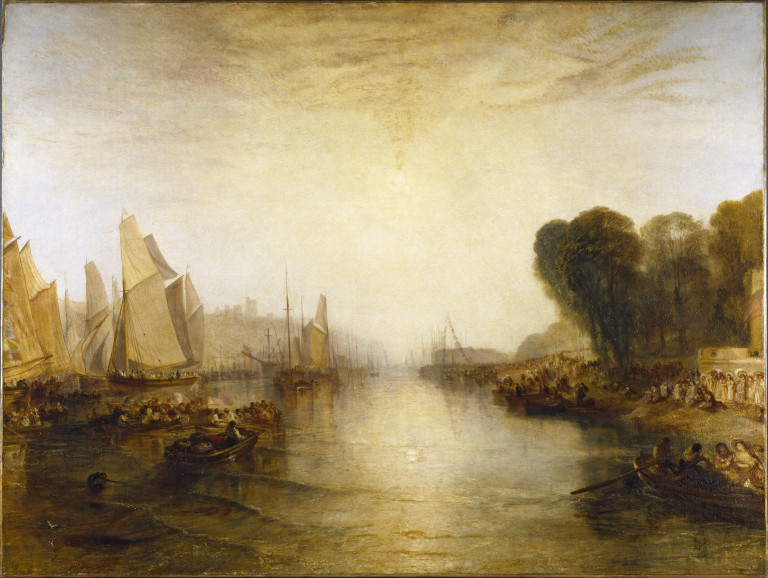
East Cowes Castle by Joseph Mallord William Turner (1775 - 1851)
This is one of two paintings by Turner depicting the Royal Yacht Club races at the Isle of Wight. They were painted for the architect John Nash, who lived in East Cowes Castle, which can be seen in the background. The critic John Ruskin believed this to be 'one of the highest pieces of intellectual art existing'. Given by John Sheepshanks, 1857 to The Edwin and Susan Davies Galleries. © Victoria and Albert Museum, London
The race originated with an invitation for the Great Exhibition of 1851 by the Earl of Winton, then Commodore of the Royal Yacht Squadron (RYS), inviting the recently formed New York Yacht Club (NYYC) to enjoy the facilities of the clubhouse of the RYS. John Cox Stevens, Commodore of the NYYC responded positively, and anticipated racing. Due to the NYS rules of the time, other races in the 1851 RYS Regatta were restricted to RYS members and their self-owned yachts, so the R. Y. S. £100 Cup was established, open to anyone to enter. At a RYS meeting on 9 May 1851, the race was scheduled for 22 August 1851. This race was to be the first of a series of challenge races for successive £100 Cups. At the time, it was normal practise for the winners to own the cups that were won, and not to return them for the next race to be won by others.
The trophy, worth 100 sovereigns in 1851, latterly affectionately known as the Auld Mug, distinguishing it from the racing regatta of the same name. The trophy, a bottomless ewer, is made out of 134 oz (3.8 kg) of silver, and is 27 in (69 cm) tall. The ewer was a stock item obtained from jeweler Robert Garrard in 1848. After the race it was engraved with the names of the yachts that raced against America, save the runner-up, Aurora.
The regatta, held on 22 August 1851, raced clockwise around the Isle of Wight in a fleet race. The course was called "The Queen's Course". The course was near Cowes Castle on the Isle of Wight, where the Royal Yacht Squadron headquarters are located. The race took place as part of the 1851 Royal Yacht Squadron Regatta.
18 yachts were entered for the race, but only 15 yachts started the race. The yacht Fernande did not make the start, while Strella and Titania both got to the starting line, though did not start the race. Those yachts that raced were America, Alarm, Arrow, Aurora, Bacchante, Beatrice, Brilliant, Constance, Eclipse, Freak, Gipsy Queen, Ione, Mona, Volante, Wyvern
The Great Exhibition of the Works of Industry of All Nations or The Great Exhibition, sometimes referred to as the Crystal Palace Exhibition in reference to the temporary structure in which it was held, was an international exhibition that took place in Hyde Park, London, from 1 May to 15 October 1851. It was the first in a series of World's Fairs, exhibitions of culture and industry that became popular in the 19th century, and it was a much anticipated event. The Great Exhibition was organized by Henry Cole and Prince Albert, husband of the reigning monarch, Queen Victoria. It was attended by famous people of the time, including Charles Darwin, Samuel Colt, members of the Orléanist Royal Family and the writers Charlotte Brontë, Charles Dickens, Lewis Carroll, George Eliot and Alfred Tennyson. Music for the opening was under the direction of Sir George Thomas Smart and the continuous music from the exhibited organs for the Queen's procession was "under the superintendence of William Sterndale Bennett".
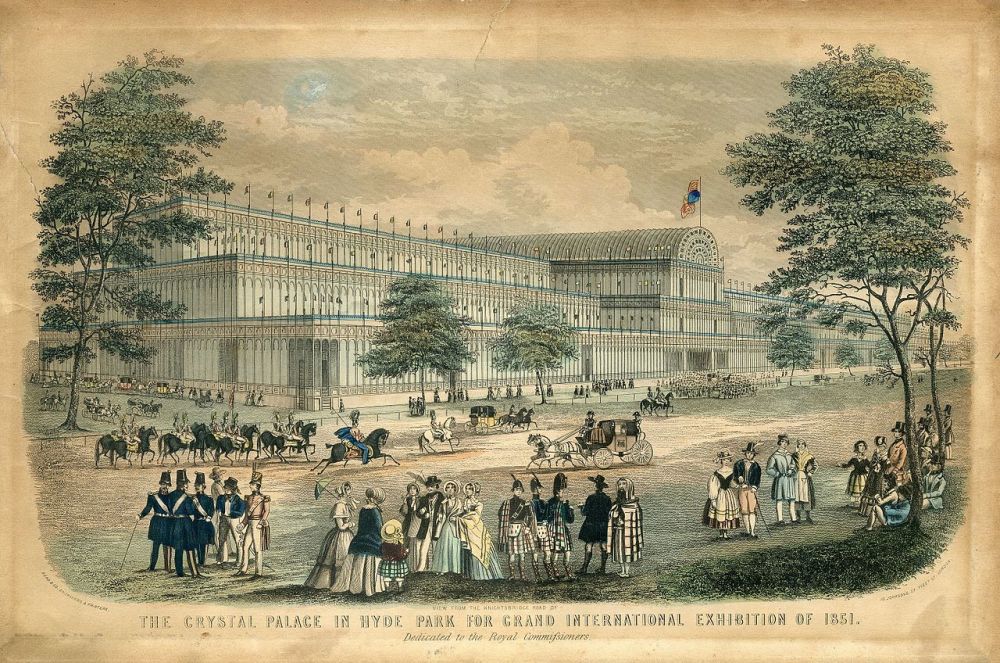
View from the Knightsbridge Road of The Crystal Palace in Hyde Park for Grand International Exhibition of 1851. Dedicated to the Royal Commissioners., London: Read & Co. Engravers & Printers, 1851.
Yachting. England V. America
ROYAL YACHT SQUADRON REGATTA.
At the request of our Aquatic Sporting readers we publish a detailed Account of the performances of the AMERICAN CLIPPER in the "All Nation Stakes" at the Cowes Regatta, and the private match with Titania. Our countrymen, like all losers, are now giving five hundred reasons why they were beaten, and double that number why they ought not to have been. The de- feat however, will undoubtedly have the effect of putting the "Britishers" on their mettle; and the next time they meet Jonathan on the wave, perhaps a different tale will be told ; and the sore of defeat be healed by the salve of
success.
ROYAL SQUADRON CUP.
Friday August 22.-The following were entered for the Cup given by the R.Y.S., to be sailed for by yachts of all nations, viz. :-:
YACHTS. TONS. OWNER..
Beatrice,.161 ..Sir W. P. Carow
Volante,. 48... J. P. Craigie
Arrow. 84...T. Chamborlayne
Wyvern. ..205...Duke of Marlborough
Ione,. 75 ..Almon Hill, Esq.
Constance...218... Marquis Conyngham
Titania....100...R. Stephenson, Esq.
Gipsy.....160...Sir H. B. Hoghton
Alarm.....193....J Weld
Mona....82..Lord A. Paget
America......170..J. C. Stevens. Esq.
Brilliant......393..G. II. Ackers, Esq.
Bacchante.... 80......B. H.Jones
Freak........ 60. .Wm. Curling
Stella....65..R. Frankland
Eclipse .....50..H. S. Fearon
Fernande,...127..Major M. Martyn
Aurora.... 47..Thomas Le Marchant.
This match was, of course, looked forward to with considerable anxiety, and we think we may safely aver that on no occasion since the establishment of the club has such general interest prevailed. The morning opened with drizzling rain, but about nine became fine, with about a five knot an hour breeze from the westward. The beach extending from Cowes Castle to the end of the parade was crowded with fashionables as the hour for starting approached.
The Titania, Fernande, and Stella, did not start. It certainly was a sight rarely to be witnessed when the numerous fleet came up in the order that had been assigned to them, with their clean and trim appearance, and the gay and varied colours floating by which they were distinguished.
At ten o'clock precisely the final starting gun was fired, and in an instant all was bustle and excitement. The utmost alacrity was displayed by the respective crews, and in less than half a minute the whole fleet was under way. The Gipsy Queen took the lead, being to the north-ward in the strength of the tide, followed by Beatrice to the southward, Volante, Ione, Con-stance, Arrow, Alarm, etc; The America was in the westward line, the whole being moored in two lines. She was the last to toke " a notion," and as soon as her canvas was up she slipped away from among the fleet, and sailed up to her
competitors, passing them in succession until she was abreast of Norris Castle, having only the Constance, Beatrice, and Gipsy before her. At 10:16 she had overhauled the two former and nearly caught the Gipsy ; the America attempted to pass to leeward of her, but the intention was frustrated. The wind dropped a little, and the Volante came up, took advantage of the light air, and in a few minutes more passed the Gipsy, the America, being about thirty fathoms in her wake. In another quarter of an hour the Gipsy again took the lead, follow ed by Volante, America, Constance, Arrow and Alarm abreast, then the others at respectful distance, and about eighty other yachts accompanying them, presenting a grand and imposing sight worthy of a Stanfield. At 10h 45min they passed Ryde, the Gipsy being well ahead, Vo lante and America abreast, the wind again un steady, the sternmost vessels bringing up the breeze. At eleven the Volante, Gipsy, and America, passed the Sandheads abreast, closely followed by the Freak, Aurora and Arrow, the huge mainsail of the Alarm, in the rear, crawl-ing along among the smaller yacht's, and appear-ed to feel the breeze, the America's sails moti-onless ; again they filled, but she had lost her station. As soon, however, as the breeze over-took her, away she went. Off Noman Volante shifted her jib, and the buoy was rounded as follows :
H.M.S Volonte,.... 11 7 0 Freak..... 11 8 20 Aurora .........11 8 30 Gipsy..... 11 8 45 America............11 9 0 Beatrice..... 11 9 15 Alarm,..... 11 9 20 Arrow.....11 10 0 Bachcante.... 11 10 15
The other yachts had positions of about half a minute between each. The wind now freshened, and the "thick stuff" or "table cloths" were observed to hang upon the hills. Off Brading Harbour the Yankee took the breeze again, and came up "hand over hand,'" and went by to leeward of the Freak and Gipsy. The beautiful Volante she had yet to conquer, she being nearly a quarter of a mile ahead of her. At twenty eight minutes past eleven, however, she contrived, without any seeming difficulty, to slip by her, as she had done with the rest, and away she went keeping in close to the island; her jib was then hauled down and stowed away. There was now a nice breeze. All at once the Volante was observed to bear away out of the line and stand for the Nab, and was soon afterwards followed by Arrow, Bacchante, and eventually Comtance, the remaining yachts keeping their course. lt was imagined by some on board the steamer that an idea had just struck her to pursue such a course, whilst others were of opinion that outside the Nab was part of the course, but the card simply stated "round the island.'" The Yankee still went away from the lot, and at 11:49 she tacked, and stood, in towards the Culver ; at noon she again tacked, and in ten minutes afterwards once more reached in to-ward the bay. At 12:38 she tacked between Sandown and Shanklin, and laid along the is-land to the southward, the others being dead to leeward. The America then set her gaff top-sail and outer jib, the breeze dying away. At 12.55 she again made a short reach towards Dunnose to shun the tide, and in a minute afterward her jib-boom (which she had procured as an addition at Cowes) broke " short as a carrot."
As there was but little wind and no "lop" it was thought that there had been a "slippery hitch" about the guy tackles ; how-ever, the only impediment was the time occu-pied in getting the " wreck " in. Onward she went, and stood off to the southward to gain a good offing. We timed her several times as 50seconds in stays. The cutters were working along shore without apparently the least chance. The Wildfire (not in the race), from her manner, without an ensign, was taken for the Aurora, she being in company with the yachts, and "mocking " the movements of the nearest vessel. At length the America got about 2 miles to windward, abreast of Steephlll, the Aurora, Freak and Volante working short tacks under the land. At 3 p.m. the America was off St Lawrence, the R. Y. S. committee steamer (with several noblemen and members of the squadron on board), keeping her company, in order to watch her actions in a seaway. She was " easy and graceful withal". On looking after the other yachts we observed that the Arrow had run aground on the ledge of rocks be tween Ventnor and Bonchurch-the east end of Mill Bay. The committee immediately directed the captain of the Queen steamer to put back to her assistance. The Majesty, another steamer, bore up likewise. The Alarm came up shortly afterwards, and launched her boat with a kedge to assist. The Majesty towed her afloat after some half hour's rocking, and the Arrow, with the Alarm and some other yachts, returned to Cowes; Aurora, Freak, and Volante tacking together in shore. At 3:20 off St Lawrence the America was well to windward with a strong W.S.W. breeze, and a "chopping" sea, the Eclipse and Bacchante being off Ventnor. The other yachts were so much to the eastward that it was impossible to note precisely their posi-tions. At 4p. m., after several tacks, the America weathered Racken-end - the south point. About a quarter of an hour previous to this the Wildfire (which many mistook for the Aurora) passed the Point, and had a good start of at least three miles, with her ballast up to wind-ward : but at 5:25, off Freshwater Bay, the America passed her, and took the conceit out of her. The Aurora was observed about seven miles astern. On nearing the Needles Rocks, the Fairy, her Majesty's tender, came out, and as we subsequently ascertained, was despatched with Lord Alfred Paget on board to report the position of the yachts. The Victoria and Albert yacht, with the royal standard at the main, having the Queen, Prince Albert, and royal family on board, remained inside the Needles. The Fairy returned, communicated with the Victoria and Albert yacht, and was again despatched to ascertain the position of the others. Returning inside the Needles the committee re-ported the information for her Majesty. At 5h. 47min. the America passed the rocks, leaving then the Aurora from seven to eight miles astern, and two other yachts to leeward ; and as the flood tide had not done outside, and the breeze dropped, it was thought it would be a late job. When inside the Needles we were joined by several other steamers full of company, and a number of yachts to witness the return of the vessels, and great was the excitement. On the return from the westward the America came up with her foresail and mainsail in " goosewing " fashion, but for an hour afterwards we kept the channel in view, and there was no appearance of the second yacht. As we passed the island shore, thousands were seen on the heights as far down as Thorness, while a vast number of boats and yachts, eager for the information, hailed the steamer as she passed them. Eventually the America reached Cowes at 8h 35min. ; another gun was fired at 8h 55min., which was inferred to be the second vessel, but which, we believe, was a mistake. It was dark, and fireworks were being exhibited, and amid the confusion it was impossible to pick the yachts out, even had there been any in the vicinity. The distance the Aurora was left outside the Needles, at our departure, with the ebb tide against her inside the Solent, would render the time of her alleged arrival impossible - unless she brought up a strong breeze with her. The Volante returned to Cowes with the loss of her bowsprit.
On board the committee's vessel were Sir Bellingham Graham, Bart., Lord Exmouth, Captain Lyon, A. Fontaine, Esq., Captain Ponsonby, Captain Corry, Messrs Harvey, Leslie, Greg, and Reynolds ; also his Excellency the American Minister, and Colonel Lawrence, attaché to the legation.
In the evening there was a brilliant display of fireworks, and every accommodation was afforded to the public from the neighbouring ports by steamers departing from Southampton at eleven p.m. after the conclusion.
Thus terminated in favour of the American builder a match which may be said to be unequalled in yacht sailing, being witnessed by thousands of persons ; and the owners and those interested in her will, no doubt return to the States with their hopes realised. Yachting.—England v. America. (1851, December 20). Bell's Life in Sydney and Sporting Reviewer (NSW : 1845 - 1860), p. 1. Retrieved from http://nla.gov.au/nla.news-article59773722
The America's Cup
The America's Cup, affectionately known as the "Auld Mug", is a trophy awarded to the winner of the America's Cup match races between two sailing yachts. One yacht, known as the defender, represents the yacht club that currently holds the America's Cup and the second yacht, known as the challenger, represents the yacht club that is challenging for the cup. The timing of each match is determined by an agreement between the defender and the challenger. The America's Cup is the oldest international sporting trophy.
The ewer was originally awarded in 1851 by the Royal Yacht Squadron for a race around the Isle of Wight in England, which was won by the schooner America. The trophy was renamed the America's Cup after the yacht and was donated to the New York Yacht Club (NYYC) under the terms of the Deed of Gift, which made the cup available for perpetual international competition.
Any yacht club that meets the requirements specified in the deed of gift has the right to challenge the yacht club that holds the cup. If the challenging club wins the match, it gains stewardship of the cup.
The history and prestige associated with the America's Cup attracts not only the world's top sailors and yacht designers but also the involvement of wealthy entrepreneurs and sponsors. It is a test not only of sailing skill and boat and sail design, but also of fundraising and management skills.
The trophy was held by the NYYC from 1857 (when the syndicate that won the cup donated the trophy to the club) until 1983 when the cup was won by the Royal Perth Yacht Club, represented by the yacht Australia II, ending the longest winning streak in the history of sport.
From the first defense of the cup in 1870 through the twentieth defense in 1967, there was always only one challenger. In 1970, for the first time, there were multiple challengers, so the NYYC agreed that the challengers could run a selection series with the winner becoming the official challenger and competing against the defender in the America's Cup match. Since 1983, Louis Vuitton has sponsored the Louis Vuitton Cup as a prize for the winner of the challenger selection series.
Early matches for the cup were raced between yachts 65–90 ft (20–27 m) on the waterline owned by wealthy sportsmen. This culminated with the J-Class regattas of the 1930s. After World War II and almost twenty years without a challenge, the NYYC made changes to the deed of gift to allow smaller, less expensive 12-metre class yachts to compete; this class was used until it was replaced in 1990 by the International America’s Cup Class which was used until 2007.
After a long legal battle, the 2010 America's Cup was raced in 90 ft (27 m) multihull yachts in a best of three "deed of gift" match in Valencia, Spain. The victorious Golden Gate Yacht Club then elected to race the 34th America's Cup in AC72 foiling, wing-sail catamarans. Golden Gate Yacht Club successfully defended the cup. The 35th America's Cup match was announced to be sailed in 50 ft foiling catamarans.
The Cup is an ornate sterling silver bottomless ewer was crafted in 1848 by Garrard & Co. Henry William Paget, 1st Marquess of Anglesey bought one and donated it for the Royal Yacht Squadron's 1851 Annual Regatta around the Isle of Wight.
It was originally known as the "R.Y.S. £100 Cup", standing for a cup of a hundred GB Pounds or "sovereigns" in value. The cup was subsequently mistakenly engraved as the "100 Guinea Cup" by the America syndicate, but was also referred to as the "Queen's Cup" (a guinea is an old monetary unit of one pound and one shilling, now £1.05). Today, the trophy is officially known as the "America's Cup" after the 1851 winning yacht, and is affectionately called the "Auld Mug" by the sailing community. It is inscribed with names of the yachts that competed for it, and has been modified twice by adding matching bases to accommodate more names.
1851: America wins the Cup
In 1851 Commodore John Cox Stevens, a charter member of the fledgling New York Yacht Club (NYYC), formed a six-person syndicate to build a yacht with intention of taking her to England and making some money competing in yachting regattas and match races. The syndicate contracted with pilot boat designer George Steers for a 101 ft (30.78 m) schooner, which was christened America and launched on 3 May 1851.
On 22 August 1851, America raced against 15 yachts of the Royal Yacht Squadron in the Club's annual 53-nautical-mile (98 km) regatta around the Isle of Wight. America won, finishing 8 minutes ahead of the closest rival. Apocryphally, Queen Victoria, who was watching at the finish line, was reported to have asked who was second, the famous answer being: "Ah, Your Majesty, there is no second."
The surviving members of the America syndicate donated the cup via the Deed of Gift of the America's Cup to the NYYC on 8 July 1857, specifying that it be held in trust as a perpetual challenge trophy to promote friendly competition among nations.
1870–1881: First challenges
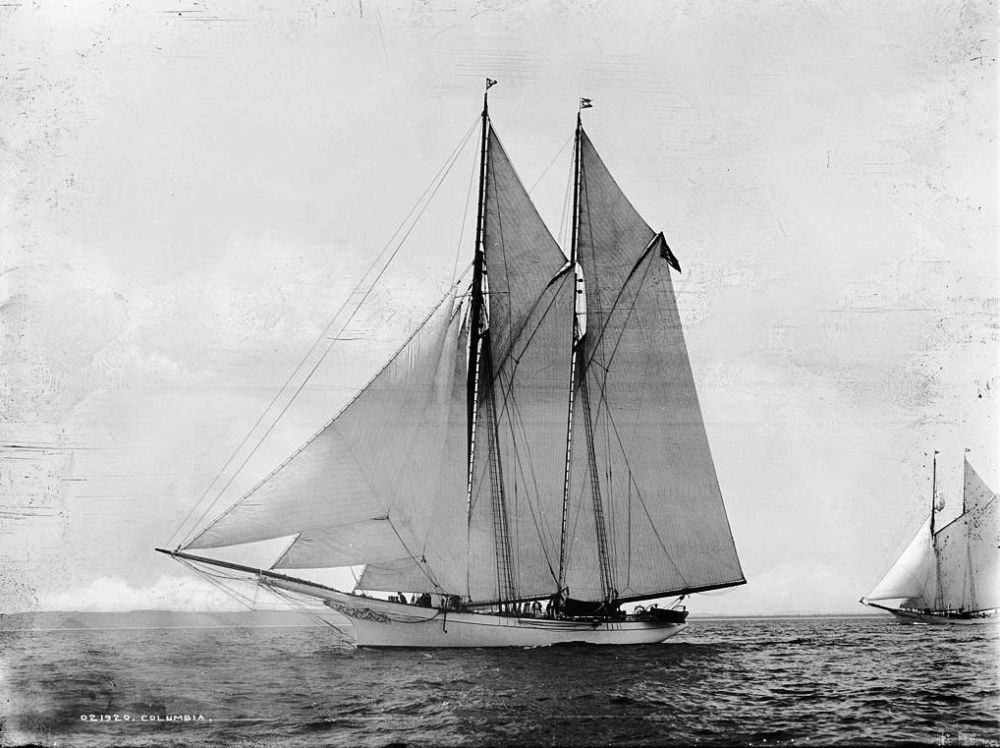
Defender Columbia, 1871 by John S. Johnston - This image is available from the United States Library of Congress's Prints and Photographs division under the digital ID det.4a15535.
No challenge to race for the Cup was issued until British railway tycoon James Lloyd Ashbury's topsail schooner Cambria (188 tons, 1868 design) beat the Yankee schooner Sappho (274.4 tons, 1867 design) in the Solent in 1868. This success encouraged the Royal Thames Yacht Club in believing that the cup could be brought back home, and officially placed the first challenge in 1870. Ashbury entered Cambria in the NYYC Queen's Cup race in New York City on 8 August against a fleet of seventeen schooners, with time allowed based on their tonnage. The Cambria only placed eighth, behind the aging America (178.6 tons, 1851) in fourth place and Franklin Osgood's Magic (92.2 tons, 1857) in the fleet's lead.
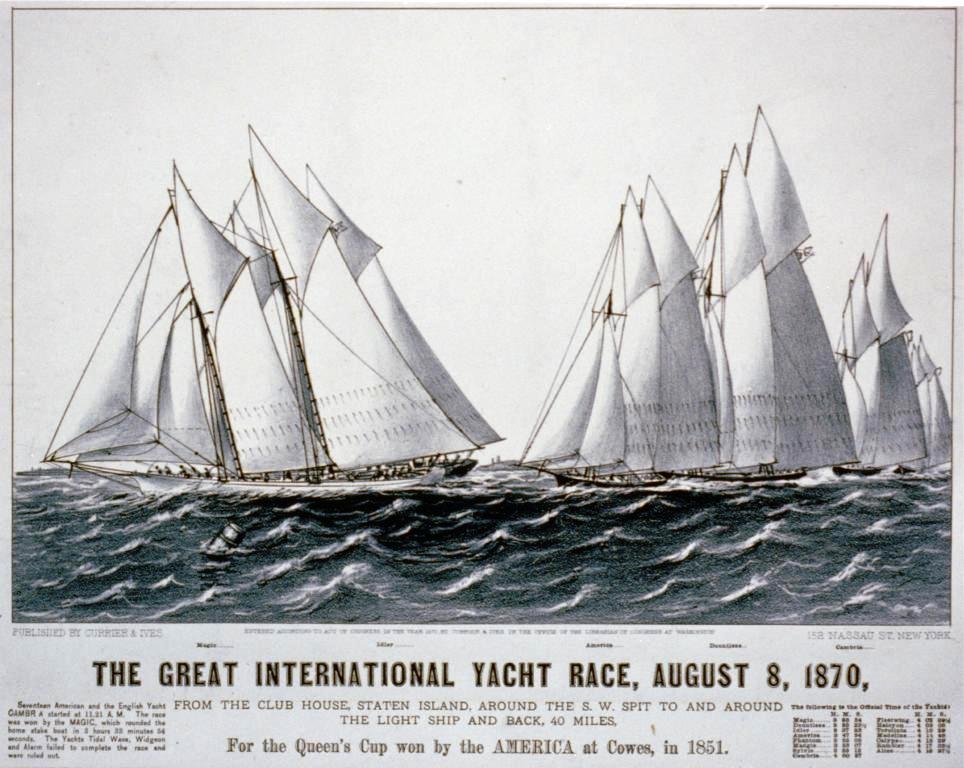
Trying again, Ashbury offered a best-of-seven match race challenge for October 1871, which the NYYC accepted provided a defending yacht could be chosen on the morning of each race. Ashbury's new yacht Livonia (264 tons) was beaten twice in a row by Osgood's new centreboard schooner Columbia (220 tons), which withdrew in the third race after dismasting. The yacht Sappho then stepped in as defender to win the fourth and fifth races, thereby successfully defending the cup.
The next challenge came from the Royal Canadian Yacht Club and was the first to be disputed between two yachts only. The schooner Madeleine (148.2 tons, 1868), a previous defender from the 1870 fleet race, easily defeated the challenger Countess of Dufferin (221 tons, 1876 design by Alexander Cuthbert). Cuthbert filed the second Canadian challenge, bankrolling, designing and sailing the first sloop challenge for the America's Cup in 1881. The small 65 ft (19.81 m) Canadian challenger Atalanta (84 tons, 1881), representing the Bay of Quinte Yacht Club, suffered from lack of funds, unfinished build and a difficult delivery through the Erie Canal from Lake Ontario to New York. In contrast, the NYYC cautiously prepared its first selection trials. The iron sloop Mischief (79 tons, 1879 design by Archibald Cary Smith) was chosen from four sloop candidates, and successfully defended the cup.
1885–1887: The NYYC Rule
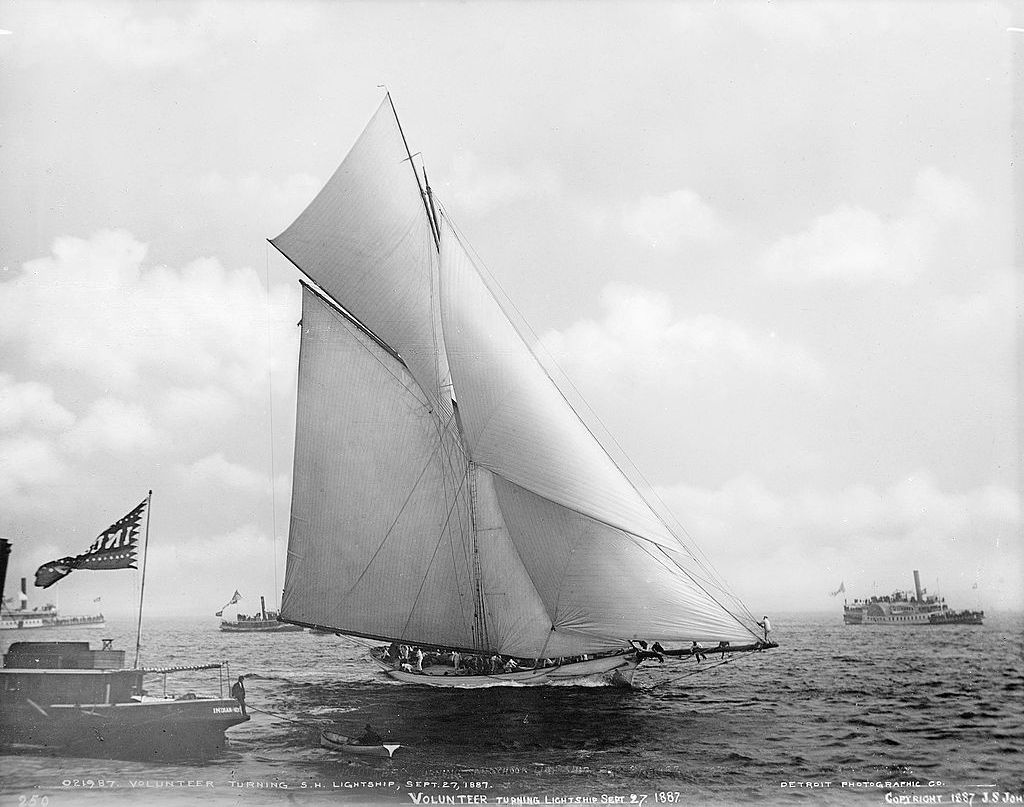
Defender Volunteer, 1887 by John S. Johnston - This image is available from the United States Library of Congress's Prints and Photographs division under the digital ID det.4a15595.
In response to the incompetent Canadian challenges, the Deed of Gift was amended in 1881 to require that challenges be accepted only from yacht clubs on the sea and that challenger yachts must sail to the venue on their own hull. Furthermore, Archibald Cary Smith and the NYYC committee devised a new rating rule that would govern the next races. They included sail area and waterline length into the handicap, with penalties on waterlines longer than 85 ft (25.91 m). Irish yacht designer John Beavor-Webb launched the challengers Genesta (1884) and Galatea (1885), which would define the British "plank-on-edge" design of a heavy, deep and narrow-keel hull, making for very stiff yachts ideal for the British breeze. The boats came to New York in 1885 and 1886 respectively, but neither would best the sloops Puritan or Mayflower, whose success in selection trials against many other candidates proved Boston designer Edward Burgess was the master of the "compromise sloop" (lightweight, wide and shallow hull with centerboard). This design paradigm proved ideal for the light Yankee airs.
In 1887, Edward Burgess repeated his success with the Volunteer against Scottish yacht designer George Lennox Watson's challenger Thistle, which was built in secret. Even when the Thistle was drydocked in New York before the races, her hull was draped to protect the secret of her lines, which borrowed from American design. Both Volunteer and Thistle were completely unfurnished below decks to save weight.
1889–1903: The Seawanhaka Rule
In 1887, the NYYC adopted the Seawanhaka Corinthian Yacht Club's rating rule, in which Bristol, RI naval architect Nathanael Herreshoff found loopholes that he would use to make dramatic improvements in yacht design and to shape the America's Cup's largest and most extreme contenders. Both Herreshoff and Watson proceeded to merge Yankee sloop design and British cutter design to make very deep S-shape fin-keeled hulls. Using steel, tobin bronze, aluminium, and even nickel for novel construction, they significantly lengthened bow and stern overhangs, further extending the sailing waterline as their boats heeled over, thus increasing their speed.
Challenger Valkyrie II, 1893
The next America's Cup challenge was initially limited to 70 ft (21.34 m) waterline in 1889, but the mutual-agreement clauses of a new 1887 Deed of Gift caused the Royal Yacht Squadron to withdraw the Earl of Dunraven's promising Watson designed challenger Valkyrie while she was crossing the Atlantic. Dunraven challenged again in 1893, pleading for a return to the longer 85 ft (26 m) limit. In a cup-crazed Britain, its four largest cutters ever were being built, including Watson's Valkyrie II for Dunraven's challenge. Meanwhile, the NYYC's wealthiest members ordered two cup candidates from Herreshoff, and two more from Boston yacht designers. Charles Oliver Iselin, who was running the syndicate behind one of the Herreshoff designs called Vigilant, gave the naval architect leave to design the yacht entirely as he willed. Herreshoff helmed Vigilant himself and beat all his rivals in selection trials, and defended the cup successfully from Valkyrie II.
Urged to challenge again in yet larger boat sizes, Dunraven challenged again in 1895 with a 90 ft (27.43 m) waterline limit. The Watson designed challenger Valkyrie III received many innovations: She would be wider than the defender, and featured the first steel mast. The NYYC ordered another defender from Herreshoff, which he had built in a closed off hangar and launched at night so as to conceal her construction: Defender used an aluminium topside riveted to steel frames and manganese bronze below waters. This saved 17 tons of displacement, but later subjected the boat to extreme electrolysis after the Cup races. Valkyrie III lost the first race, was deemed disqualified in the second race following a collision with Defender before the start line despite finishing first, and in turn withdrew from the contest. The unraveling of the races left Dunraven in a bitter disagreement with all parties over fairness of the cup committee concerning claims. After he asserted that he had been cheated, his honorary membership of the NYYC was revoked. Henry "Hank" Coleman Haff, was inducted into America's Cup Hall of Fame in 2004 for his sailing of Defender in 1895 and bringing the cup back. At age 58, Hank Haff was the oldest cup winner in the history of the race.
The climate was estranged until Scottish businessman Sir Thomas Lipton became the financial backer for the Royal Ulster Yacht Club's 1899 challenge. William Fife was chosen to design the challenging yacht because of past success in American waters. The yachts increased yet again in size, and this time Herreshoff fitted a telescopic steel mast to his defender Columbia, but his largest contribution was to recruit Scottish-American skipper Charlie Barr. The latter had helmed Fife designs in Yankee waters before, and he had shown perfect coordination with his hand-picked Scandinavian crew. Barr successfully helmed Columbia to victory, and Lipton's noted fair play provided unprecedented popular appeal to the sport and to his tea brand.
Although upset with the Shamrock, Lipton challenged again in 1901, turning this time to George Lennox Watson for a "cup-lifter": Shamrock II, Watson's fourth and final challenger, was the first cup contender to be thoroughly tank-tested. To defend the Cup, businessman Thomas W. Lawson funded for Boston designer Bowdoin B. Crowninshield a daring project: his yacht Independence was capable of unrivalled performance because of her extremely long sailing waterline, but she was largely overpowered and unbalanced and suffered from structural issues. Furthermore, Lawson's failure to commit to the NYYC's terms for defending the Cup defaulted the Independenceʼs elimination. Herreshoff had again received a commission from the NYYC, but had failed to secure Charlie Barr to skipper his new yacht Constitution. Instead, the Columbiaʼs syndicate kept Barr's crew and tried another defense. Unexpectedly, Barr led the Columbiaʼs crew to win the selection trials, and to successfully defend the cup again.
Lipton persisted in a third challenge in 1903. With the aim to fend off Lipton's challenges indefinitely, the NYYC garnered a huge budget for a single cup contender, whose design would be commissioned to Herreshoff again. Improving on the Independence and his previous designs, the new defender Reliance remains the largest race sloop ever built. She featured a ballasted rudder, dual-speed winches below decks, and a cork-decked aluminium topside that hid running rigging. The design focus on balance was exemplary, but the extreme yacht also required the skills of an excellent skipper, which defaulted choice options to Charlie Barr. Facing the equally bold challenger Shamrock III, Barr led the Reliance to victory in just three races.
1914–1937: The Universal Rule
Despite the immense success of the Reliance, she was used only one season, her design and maintenance keeping her from being used for any other purpose than for a cup defense. The extremity of both 1903 cup contenders encouraged Nathanael Herreshoff to make boats more wholesome and durable by devising a new rule. Proposing in the same year the Universal Rule, he added the elements of overall length and displacement into the rating, to the benefit of heavy, voluminous hulls and also divided boats into classes, without handicapping sail area. This went against the American Yacht Clubs' and the British Yacht Racing Association's general desire to promote speed at all costs for cup boats, but the NYYC adopted Herreshoff's proposal. Lipton long pleaded for a smaller size of yachts in the new rule, and the NYYC conceded to seventy-five footers in 1914. Lipton turned to Charles Ernest Nicholson for his fourth challenge, and got a superb design under the inauspicious shape of Shamrock IV, with a flat transom.[26] She was the most powerful yacht that year, and the NYYC turned out three cup candidates to defend the cup: of George Owen's Defiance and William Gardner's Vanitie, it was Herreshoff who designed the wisest of all contenders.[27] His last design for the cup, the Resolute, was small, which earned significant time allowance over other yachts. Barr had died, but his crew manned the Resolute, which faced stiff competition from Vanitie, but went on to win the selection trials, before the Cup was suspended as World War I broke out.
Shamrock IV, was crossing the Atlantic with the steam yacht Erin, destined for Bermuda, when Britain declared war on Germany on 5 August 1914. Harold Stirling Vanderbilt, the Commodore of the New York Yacht Club, sent his own yacht, the Vagrant, from Rhode Island to Bermuda to meet them and escort them to the US. The Vagrant arrived on the 8th. Having no radio, the crew were unaware of the declaration of war. Finding all navigational markers missing, they attempted to pick their own way in through the barrier reef. St. David's Battery fired a warning shot to bring them to a halt. The Shamrock IV and Erin arrived the next day. The America's Cup was cancelled for that year.
The Shamrock IV and Erin proceeded to New York, from where the Erin returned to Britain while Shamrock IV was laid up in the Erie Basin dry dock until 1920, when she received some adjustments to her build and ballast, just before the races were held. Despite Shamrock IV's severe rating, she took the first two races from the defender Resolute, and came closer to winning back the Cup than any previous challenger. The Resolute won every subsequent race of the event.
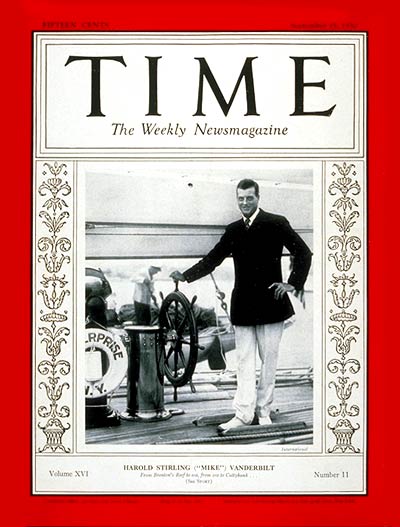
Harold Vanderbilt, Enterprise's skipper, 1930
Shamrock IV was never raced again, but the universal rule drew significant appeal, especially in the small M-Class. Believing that the new rule offered a serious opportunity for the British to take the Cup, Lipton challenged for the fifth and last time at age 79, in 1929. The J-Class was chosen for the contest, to which were added Lloyds' A1 scantling rules in order to ensure that the yachts would be seaworthy and evenly matched, given the Deed of Gift requirement for yachts to sail to the match on their "own bottom." The waterline length was set between 76 ft (23.16 m) and 88 ft (26.82 m), and there would be no time allowance. Novel rigging technology now permitted the Bermuda rig to replace the gaff rig. Nicholson was chosen to design challenger Shamrock V, and despite the Wall Street Crash, four NYYC syndicates responded to the threat and built a cup contender each.[29] The venue was moved to Newport, Rhode Island, where, the Herreshoff Manufacturing Company's new naval architect Starling Burgess used his success in the M-Class and his experience as a wartime plane designer to build the Vanderbilt syndicate's defender Enterprise, the smallest J-Class. Meanwhile, Herreshoff's son, Lewis Francis Herreshoff, designed a radical boat: The Whirlwind, despite being the most advanced boat with her double-ended "canoe" build and electronic instruments, maneuvered too clumsily. The old 75-footers Resolute and Vanitie were rebuilt and converted to the J-Class to serve as trial horses. The Enterprise's skipper Harold Vanderbilt won the selection trials with great difficulty. When the Shamrock V was revealed, she was an outdated wooden boat with a wooden mast and performed poorly to windward. Enterprise was then fitted with the World's first duralumin mast, very lightweight at 4,000 lb (1,800 kg), and beat her opponent soundly.
Lipton died in 1931, and English aviation industrialist Sir Thomas Sopwith bought the Shamrock V with the intent of preparing the next challenge. To Nicholson's skills, he added aeronautical expertise and materials that would intensify the rivalry into a technological race. In 1934, the Royal Yacht Squadron issued a challenge for Sopwith's newly built challenger Endeavour. Being steel-plated, she was less disfavoured than the Shamrock V, especially after a minimum mast weight limit was set to 5,500 lb (2,500 kg), as this made American duralumin technology less advantageous for this contest. Endeavour received significant innovations, but Sopwith failed to secure the services of his entire Shamrock V professional crew due to a pay strike. He hired amateurs to complete his team, and while the Endeavour was described unanimously as the faster boat in the Cup, taking the first two races, failed tactics and crew inexperience lost her the following four races to Vanderbilt's new defender Rainbow.
To challenge again, Sopwith prepared himself a year early. In 1936 Nicholson designed and built the Endeavour II to the maximum waterline length allowed, and numerous updates to the rig made her even faster than her predecessor. A change in the America's Cup rules now allowed a contending yacht to be declared 30 days before the races, so both the Endeavour and the Endeavour II were shipped to Newport, where the RYS held selection series before declaring Endeavour II as the challenger. Meanwhile, Harold S. Vanderbilt, taking all syndicate defense costs to himself, commissioned Starling Burgess and the young designer Olin Stephens to provide designs. They anonymously produced three designs each, and thoroughly tank-tested boat models of the six designs, until model 77-C was selected for its projected performance in light airs. The resulting defender Ranger was even more accomplished than her challenger, and Vanderbilt steered his last J-Class boat to a straight victory.
1956–1987: The Twelve-Metre Rule
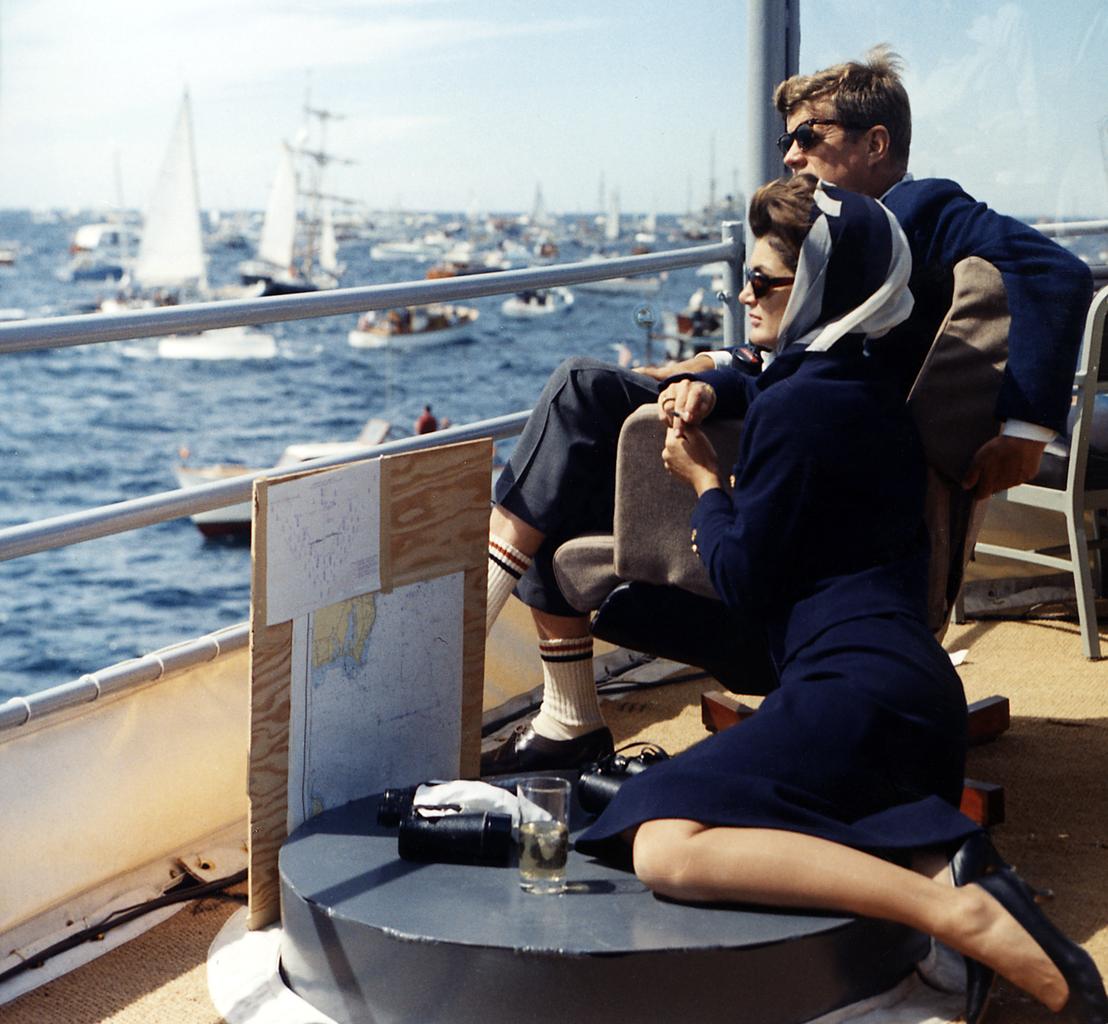
President Kennedy and wife watching the America's Cup, 1962: Watching the America's Cup Race. Mrs. Kennedy, President Kennedy, others. Off Newport, RI, aboard the USS Joseph P. Kennedy, Jr. 15 September 1962 - Robert Knudsen White House Photographs, Robert Knudsen (1928-1989), Office of the Naval Aide to the President
The J-class yachts from the 1930s remained the default for the cup, but post-war economic realities meant that no-one could afford to challenge in this hugely expensive class. As twenty years had passed since the last challenge, the NYYC looked for a cheaper alternative in order to restart interest in the cup. In 1956 Henry Sears led an effort to replace the J-class yachts with 12-metre class yachts, which are approximately 65 to 75 feet (20 to 23 m) in overall length.
The first post-war challenge was in 1958, again from the British. Briggs Cunningham, the inventor of the cunningham sail control device, as skipper with Sears as navigator led Columbia to victory against Sceptre, which was designed by David Boyd at Alexander Robertson and Sons Ltd (Yachtbuilders), for a Royal Yacht Squadron Syndicate, chaired by Hugh Goodson.
1962–1983: The Australian challengers
The first Australian challenge was in 1962, when Gretel lost to the NYYC's Weatherly, designed by Philip Rhodes. A second Boyd/Robertson challenger, Sovereign, lost to the Olin Stephens–designed Constellation in 1964. In 1967, another Australian challenger, Dame Pattie, lost to the innovative Olin Stephens design Intrepid (which won again in 1970, to become the second yacht, after Columbia, to defend the Cup twice).
Defender Freedom, 1980
For the 1970 America's Cup, interest in challenging was so high that the NYYC allowed the Challenger of Record (the original yacht club presenting the challenge accepted for the match) to organize a regatta among multiple challengers with the winner being substituted as challenger and going on to the cup match. This innovation has been used ever since, except for the default deed of gift matches in 1988 and 2010.
Alan Bond, an Australian businessman, made three unsuccessful challenges between 1974 and 1980. In 1974 the cup was successfully defended by Courageous, which successfully defended again in 1977, at which time she was skippered by Ted Turner. In 1980 the Cup was defended by Freedom.
1983: Australia II wins the Cup
The winged keel of the victorious challenger Australia II, 1983
Bond returned in 1983 for a fourth challenge, complete with a symbolic golden wrench which he claimed would be used to unbolt the cup from its plinth, so that he could take it back to Australia. In 1983 there were seven challengers for the cup competing for the inaugural Louis Vuitton Cup, the winner of which would go on to the America's Cup match against the NYYC's yacht selected in their trials. Bond's yacht, Australia II, designed by Ben Lexcen, skippered by John Bertrand, and representing the Royal Perth Yacht Club, easily won the Louis Vuitton challenger series, and Dennis Conner in Liberty was selected for the Cup defense.
Sporting the now famous Boxing Kangaroo flag and the controversial winged keel designed by Ben Lexcen, the hull of Australia II was kept under wraps between races and was subject to attempts by the NYYC to disqualify the boat. In the cup races, the Australians got off to a bad start with equipment failures and false starts giving the defenders a head start. But it was not a repeat of the last 132 years with the Australians coming back to win the 1983 America's Cup 4–3 in a best-of-seven format. This was the first time the NYYC had lost the cup in 132 years and 26 challenges. Alan Bond joked that the cup would be renamed "The Australia's Cup".[citation needed]
1987: Technology and professionalism are increasingly important
For the first time since its inception the America's Cup was defended outside of the US off the coast of Fremantle. This was a new era for the cup with interest in competing being shown by many countries.
Representing the San Diego Yacht Club, Conner returned to win the 1987 America's Cup. His yacht Stars & Stripes 87 earned the right to challenge by winning the 1987 Louis Vuitton Cup against an unprecedented field of 13 challenger syndicates. In the America's Cup regatta he faced defender Iain Murray sailing Kookaburra III, who had defeated Alan Bond's Australia IV in the defender selection trials. Stars & Stripes 87 defeated Kookaburra III four races to nil.
Technology was now playing an increasing role in yacht design. The 1983 winner, Australia II, had sported the revolutionary winged keel, and the New Zealand boat that Conner had beaten in the Louis Vuitton Cup final in Fremantle was the first 12-metre class to have a hull of fiberglass, rather than aluminium or wood.
The 12-metre class rules stipulated that the hull had to be the same thickness throughout and could not be made lighter in the bow and stern. The other challengers demanded that core samples be taken from the plastic hull to show its thickness. At one press conference Dennis Conner asked, "Why would you build a plastic yacht ... unless you wanted to cheat?" Despite attempts to defuse the situation, the "cheating comment" added to the controversy surrounding the Louis Vuitton challenge races. Chris Dickson, skipper of the Kiwi Magic (KZ 7), took the controversy in stride and with humor, and Conner has subsequently stated his regret over his comment.[35] New Zealand syndicate head Sir Michael Fay's comment was that core samples would be taken "over my dead body". Eventually some small holes were drilled to test the hull, and ultrasonic testing was done to rule out air pockets in the construction. The boat was found to be within class rules, and the issue was set aside. Fay ceremoniously lay down in front of the measurer before the samples were taken.
1988: The Mercury Bay Challenge
In 1987, soon after Conner had won back the cup with Stars and Stripes but before the San Diego Yacht Club had publicly issued terms for the next regatta, a New Zealand syndicate, again led by merchant banker Sir Michael Fay, lodged a surprise challenge. Fay challenged with a gigantic yacht named New Zealand (KZ1) or the Big Boat, which with a 90-foot (27 m) waterline, was the largest single masted yacht possible under the original rules of the cup trust deed. This was an unwelcome challenge to the San Diego Yacht Club, who wanted to continue to run Cup regattas using 12-metre yachts. A legal battle ensued over the challenge, with Justice Carmen Ciparick of the New York State Supreme (trial) Court (which administers the Deed of Gift) ruling that Fay's challenge on behalf of Mercury Bay Boating Club (MBBC) was valid. The court ordered SDYC to accept it and negotiate mutually agreeable terms for a match, or to race under the default provisions of the Deed, or to forfeit the cup to MBBC.
Forced to race, and lacking time for preparation, Conner and SDYC looked for a way to prevail. They recognized that a catamaran was not expressly prohibited under the rules. Multihulls, due to a lower wetted surface area and vastly lower mass, are inherently faster than equal-length monohulls. Conner, however, left nothing to chance and commissioned a cutting edge design with a wing sail, named—as his 12-metre yachts had been—Stars and Stripes.
The two yachts raced under the simple terms of the deed in September, 1988. New Zealand predictably lost by a huge margin. Fay then took SDYC back to court, arguing that the race had been unfair, certainly not the "friendly competition between nations", envisaged in the Deed of Gift. Ciparick agreed and awarded New Zealand the Cup. However, Ciparick's decision was overturned on appeal and SDYC's win was reinstated. Fay then appealed to New York's highest court and lost. Thus SDYC successfully defended the cup in what observers described as the most controversial cup match to that point.[37] (The 2010 America's Cup was a direct descendant of the 1988 cup, as it featured two gigantic multi-hull yachts and generated even more legal activity and controversy ).
1992–2007: The IACC rule
In the wake of the 1988 controversies, the International America's Cup Class (IACC) was introduced, replacing the 12-metre class that had been used since 1958.
In 1992, USA-23 of the America team, skippered by billionaire Bill Koch and sailing legend Harry “Buddy” Melges, defeated the Italian challenger Il Moro ITA-25, owned by billionaire Raul Gardini's Il Moro di Venezia, 4–1.
1995
In 1995, the Royal New Zealand Yacht Squadron syndicate Team New Zealand, skippered by Russell Coutts, first won the challenger series in NZL 32, dubbed "Black Magic" because of her black hull and uncanny speed. Black Magic then easily defeated Dennis Connor's Stars & Stripes team, 5–0, to win the cup for New Zealand. Although team Young America's cup candidate yacht USA-36 was defeated in defender trials by Stars & Stripes' USA-34, the San Diego Yacht Club elected to defend the cup with USA-36 crewed by Stars & Stripes. The run-up to the 1995 Cup was notable for the televised sinking of oneAustralia during the fourth round robin of the Louis Vuitton challenger selection series, with all hands escaping uninjured. The 1995 defender selection series also had the first mostly female (with one man) crew sailing the yacht USA-43, nicknamed "Mighty Mary".
On the 14th of March 1996, a man (Benjamin Peri Nathan; who was subsequently tried, convicted and jailed) entered the Royal New Zealand Yacht Squadron's clubroom and damaged the America's Cup with a sledgehammer. The damage was so severe that it was feared that the cup was irreparable. London's Garrards silversmiths, who had manufactured the cup in 1848, painstakingly restored the trophy to its original condition over three months, free of charge. In 2003, an extra 20 cm was added to the cup's base to accommodate the names of future winners.
At Auckland in 1999–2000, Team New Zealand, led by Sir Peter Blake, and again skippered by Russell Coutts, defeated the Italian Prada Challenge from the Yacht Club Punta Ala. The Italians had previously beaten the AmericaOne syndicate from the St Francis Yacht Club in the Louis Vuitton Cup final. This was the first America's Cup to be contested without an American challenger or defender.
During the Twelve-Metre era, the New York Yacht Club, citing the Deed language that the Cup should be "perpetually a Challenge Cup for friendly competition between foreign countries", had adopted several interpretive resolutions intended to strengthen nationality requirements. By 1980, these resolutions specified that besides being constructed in the country of the challenger or defender, a yacht had to be designed by and crewed by nationals of the country where the yacht club was located. Globalization made it increasingly impractical to enforce design nationality rules, and starting in 1984, the Royal Perth Yacht Club began relaxing this requirement. Numerous members of the New Zealand AC 2000 team became key members of the Swiss 2003 Alinghi challenge, led by biotechnology entrepreneur Ernesto Bertarelli. To satisfy the crew nationality requirements, New Zealand team members of Alinghi took up residence in Switzerland.
In 2003, several strong challengers vied for the right to sail for the cup in Auckland during the challenger selection series. Bertarelli's team representing the Swiss yacht club, Société Nautique de Genève (SNG), beat all her rivals in the Louis Vuitton Cup and in turn won the America's Cup 5–0. In doing so, Alinghi became the first European team in 152 years of the event’s history to win the cup.
For the 2007 challenge, SNG rescinded all interpretive resolutions to the deed, essentially leaving "constructed in country" as the only remaining nationality requirement. The 2007 defense of the cup was held in Valencia, Spain. This was the first time since the original 1851 Isle of Wight race that the America's Cup regatta had been held in Europe, or in a country different from that of the defender (necessary because Switzerland, despite having huge lakes and a national passion for sailing, does not border a "sea or arm of the sea" as specified in the Deed). Eleven challenging yacht clubs from 9 countries submitted formal entries. The challenger selection series, the Louis Vuitton Cup 2007, ran from 16 April to 6 June 2007. Emirates Team New Zealand won the challenger series finale 5–0 against Italians Luna Rossa and met Alinghi between 23 June and 3 July 2007. Ernesto Bertarelli's Team- Alinghi successfully defended the America's Cup 5–2, under the colors of SNG.
2010: The Golden Gate Challenge
Challenger USA-17, 2010
After Société Nautique de Genève successfully defended the trophy in the 32nd America's Cup, they accepted a challenge from Club Náutico Español de Vela (CNEV) a Spanish yacht club formed expressly for the purpose of challenging for the cup and keeping the regatta in Valencia. When SNG and CNEV published their protocol for the 33rd America's Cup, there was criticism over its terms, with some teams and yacht clubs calling it the worst protocol in the history of the event. Golden Gate Yacht Club (GGYC) then filed its own challenge for the cup and also filed a court case asking that CNEV be removed as being unqualified under the deed of gift, and that GGYC be named the challenger, being the first club to file a conforming challenge.
There followed a long and acrimonious legal battle, with the New York Court of Appeals finally deciding on 2 April 2009 that CNEV did not qualify as valid challenger, and that the GGYC was thus the rightful challenger.
Since the two parties were unable to agree otherwise, the match took place as a one-on-one Deed of Gift match with no other clubs or teams participating. The match was sailed in gigantic, specialized 90 ft (27 m) multihull yachts in a best-of-three race series in Valencia, Spain from 8 to 14 February 2010. The rigid wing sail of the challenging trimaran USA-17 provided a decisive advantage, and it won the 2010 America's Cup 2–0.
2013: The AC72 rule
Defender Oracle, 2013
The Challenger of Record for the 34th America's Cup was Club Nautico di Roma, whose team Mascalzone Latino had competed in the challenger selection series for the 2007 America's Cup.[46][47] In September, 2010, GGYC and Club Nautico di Roma announced the protocol for AC34, scheduling the match for 2013 in a new class of boat, the AC72, a wing-sailed catamaran. Paralleling the "Acts" of the 32nd America's Cup—a series of preliminary events in different venues leading-up to the actual event—a new series, the America's Cup World Series was to be run using AC45 class boats (smaller one-design versions of the AC72s), in various world venues in 2011 and 2012.
On 12 May 2011, Club Nautico di Roma withdrew from the competition, citing challenges in raising sufficient funds to field a competitive team. As the second yacht club to file a challenge, the Royal Swedish Yacht Club assumed the duties of the challenger.
Rumors of stable hydrofoiling of an AC72 were confirmed when Emirates Team New Zealand's AC72 yacht Aotearoa was seen to be sailing on hydrofoils in August, 2012. This triggered a technology race in foil development and control. The Royal New Zealand Yacht Club won the right to sail in the America's Cup match easily beating the Italian and Swedish challengers in the Louis Vuitton Cup. The resulting match between the USA and NZ was the longest on record both in calendar time, and the number of races, with the Golden Gate Yacht Club staging an improbable come-from-behind victory, winning eight straight races to defend the cup and beat New Zealand 9–8.
2017 America's Cup
Oracle Team USA stands to defend the America's Cup May 26–June 27, 2017 on behalf of the Golden Gate Yacht Club. Bermuda is slated to host the Cup, where racing will take place on the Great Sound. Preliminary races will be held in Portsmouth, Gothenburg, and Bermuda in foiling AC45s. After the 2013 America's Cup, the Golden Gate Yacht Club accepted a notice of challenge from the Hamilton Island Yacht Club, with whom a new protocol and a smaller 62 ft wingsail foiling catamaran class rule were proposed in cooperation with participating challengers.The Hamilton Island Yacht Club withdrew from the America's Cup in July 2014, citing unanticipated cost in mounting its challenge. The exiting challenger of record was replaced by a challenger committee, where decisions are made by popular vote. When an even smaller 50ft wingsail foiling catamaran class rule amendment was voted in April 2015, Luna Rossa Challenge also withdrew, citing significant costs wasted on the development of the larger vessel. Yachts from France, Japan, New Zealand, Sweden, and the UK remain in the competition to challenge for the cup. In June 2016, for the first time in history an America's Cup race included fresh water sailing, when preliminary races were held in Chicago, USA, on Lake Michigan.
America's Cup. (2017, May 30). In Wikipedia, The Free Encyclopedia. Retrieved from https://en.wikipedia.org/w/index.php?title=America%27s_Cup&oldid=783023208
A Few Classics From Earlier Eras
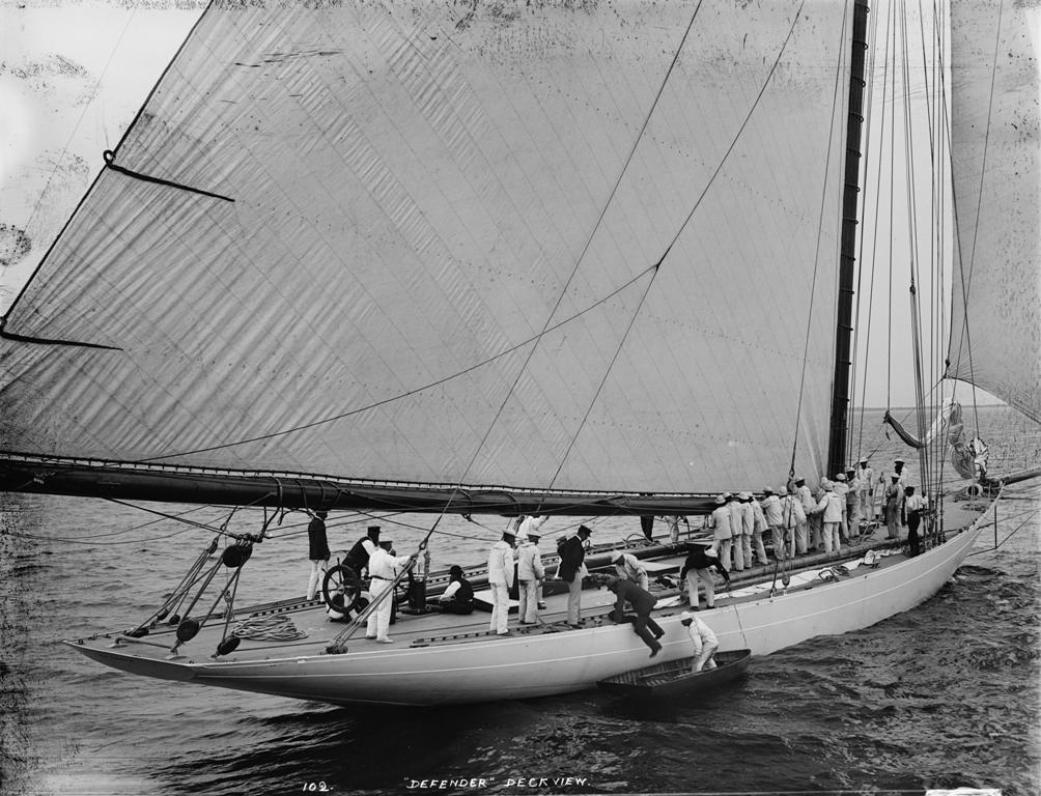
Defender, deck view - 1895 July 22. By John S. Johnston, photographer, Library of Congress Prints and Photographs Division Washington, D.C. 20540 USA Reproduction Number: LC-DIG-det-4a21615.
Defender was the victorious United States defender of the tenth America's Cup in 1895 against challenger Valkyrie III. Defender was designed by Nathanael Greene Herreshoff and built by the Herreshoff Manufacturing Company in 1895. It was Herreshoff's second victorious America's Cup defender design.
Defender was a sloop with all-metal construction: steel, aluminum, and manganese bronze. It was owned by William Kissam Vanderbilt, Edwin Dennison Morgan and Charles Oliver Iselin, and skippered by Henry C. Haff.
Defender defeated the New York Yacht Club's Vigilant then went on to defend the cup against British keel cutter Valkyrie III. Following the contest, Defender was towed to the residence of C. Oliver Iselin in New Rochelle, New York where it remained docked for four years without sailing. In 1899 J. Pierpont Morgan and W. Buttler Duncan rebuilt Defender to race trials against the America's Cup defense candidate, Columbia.
The yacht was towed to Herreshoff's Bristol yard for restoration to enable it to race in the selection trials for the 1899 defence. Following the selection trials, Defender returns to its mooring and was finally broken up in 1901.
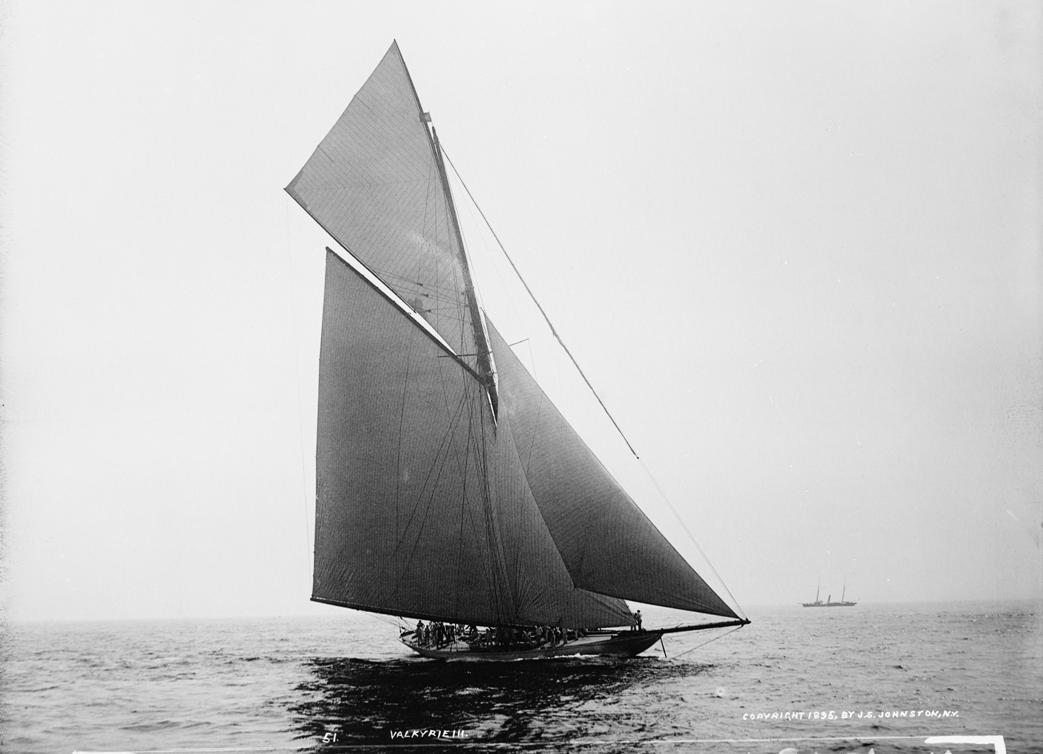
Racing yacht 'Valkyrie III', copyright 1895 by J. S. Johnston, N.Y. John S. Johnston - Gift: State Historical Society of Colorado; 1949. Reproduction Number: LC-D4-62589 This image is available from the United States Library of Congress's Prints and Photographs division under the digital ID det.4a21916.
Valkyrie III, officially named Valkyrie, was the unsuccessful British challenger of the ninth America's Cup race in 1895 against American defender Defender.
Valkyrie III, a keel cutter, was designed by George Lennox Watson and built at the D&W Henderson on the River Clyde in 1894-1895 for a syndicate including Lord Londsale, Lord Wolverton, Captain Henry McCalmont and headed by Lord Dunraven of the Royal Yacht Squadron. Valkyrie III had a steel frame, a hull planked with American elm and teak, and a pine deck.
Valkyrie III was launched on May 27, 1895. After a few mixed test races (for which she was later criticized for lack of previous competition) she sailed to New York to prepare for the ninth America's Cup. Valkyrie III was beaten by Defender in the first race of the 1895 America's Cup. Valkyrie III fouled the leeward Defender during the prestart to the second race, breaking her starboard shrouds, but the latter did not protest and the race took place nevertheless, with Valkyrie III finishing ahead of Defender on corrected time. In turn the America's Cup committee ruled to disqualify the Valkyrie III because of the foul and dismissed Lord Dunraven counter-proposal to re-race. Valkyrie III was withdrawn immediately after the start of the third race and Defender ran over the course unchallenged and successfully defended the America's Cup. Lord Dunraven claimed the Americans had cheated, creating a public controversy that jeopardized the future challenges for the America's Cup race until Sir Thomas Lipton issued his own Shamrock challenge in 1898. In 1899 Valkyrie III' hull was repaired and repainted to serve as a trial horse for Shamrock, but eventually she did not serve that purpose. She was broken up in 1901.
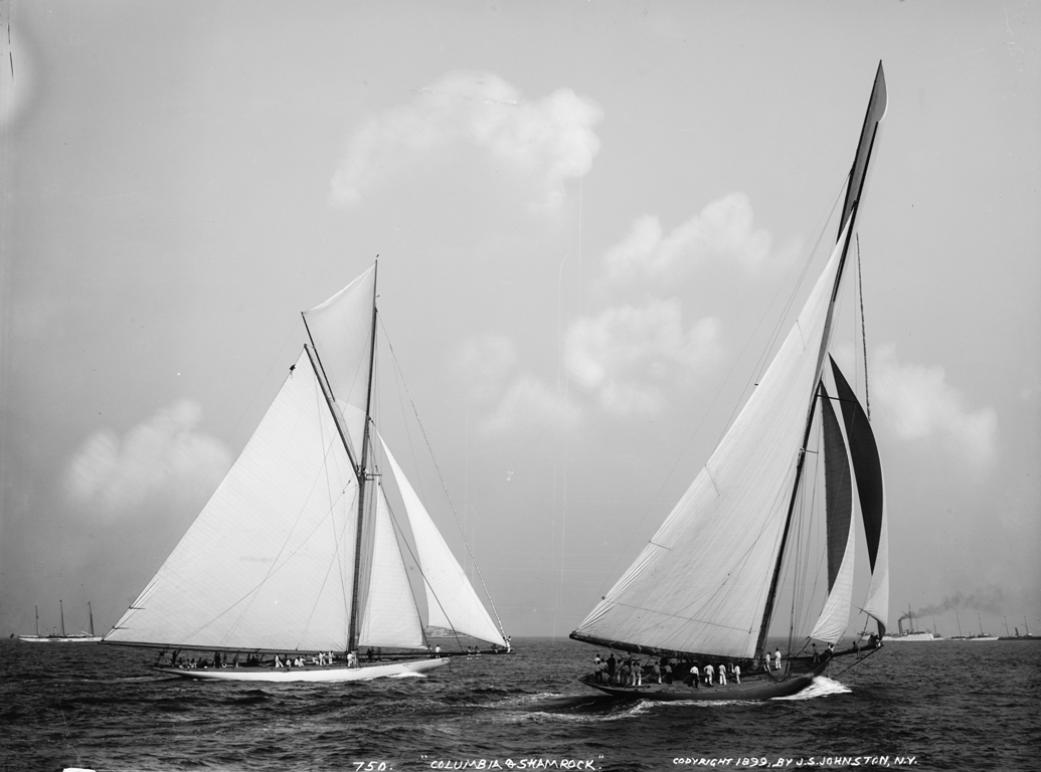
Yachts Columbia and Shamrock, the contestants in the 1899 America's Cup. Photo by John S. Johnston - This image is available from the United States Library of Congress's Prints and Photographs division under the digital ID det.4a21587.
Shamrock was a racing yacht built in 1898 that was the unsuccessful Irish challenger for the 1899 America's Cup against the United States defender, Columbia. Shamrock was designed by third-generation Scottish boatbuilder, William Fife III, and built in 1898 by J. Thorneycroft & Co., at Church Wharf, Chiswick, for owner Sir Thomas Lipton of the Royal Ulster Yacht Club (and also of Lipton Tea fame). However her draft was too great for construction at Chiswick and she was built at Millwall.
Shamrock (also known as Shamrock I, to distinguish her from her successors) was built in 1898 under a shroud of secrecy, and christened by Lady Russell of Killowen at its launch on 26 June 1899. Shamrock featured a composite build, with manganese-bronze bottom and aluminium topside clinkerbuilt over a steel frame and a pine decking. She was initially skippered by Captain Archibald Hogarth.
During her trials she raced against the 1895 America's Cup challenger, Valkyrie III, as well as twice beating HMY Britannia in regattas on the Solent. She sailed to New York for the America's Cup race in the summer of 1899. The Cup defender Columbia beat Shamrock in all three races. She returned to Britain in the autumn of 1899, towed by Lipton's steam yacht, Erin. She was subsequently refitted to serve as a trial horse for Shamrock II and Shamrock III.
Sir Thomas Johnstone Lipton
Sir Thomas Johnstone Lipton, 1st Baronet, KCVO (10 May 1848 – 2 October 1931) was a Scotsman of Ulster-Scots parentage who was a self-made man, merchant, and yachtsman. He engaged in extensive advertising for his chain of grocery stores and his brand of Lipton teas. He boasted that his secret for success was selling the best goods at the cheapest prices, harnessing the power of advertising, and always being optimistic. He was the most persistent challenger in the history of the America's Cup.
Lipton was born in a tenement in Crown Street, Glasgow on 10 May 1848. His parents, Thomas Lipton senior and Frances Lipton (née Johnstone), were Ulster-Scots from County Fermanagh. The Liptons had been smallholders in Fermanagh for generations but, by the late 1840s, Thomas Lipton's parents had been forced to leave Ireland due to the potato famine of 1845. Moving to Scotland in search of a better living for their young family, the Liptons had settled in Glasgow by 1847. Lipton's father would hold a number of occupations throughout the 1840s and 1850s, including working as a labourer and as a printer.
Although Thomas Lipton would later state that he was born at his family's home in Crown Street in the Gorbals in 1850 there is no record of this in the parish register for that period. In the 1851 census, however, the family were recorded as living in the north of Glasgow, with young Thomas being listed as being aged 3 years old. It would appear that he was therefore born in 1848. Thomas's siblings, three brothers and one sister, all died in infancy, but Thomas, despite being the youngest, survived.
Thomas Lipton was educated at St. Andrew's Parish School close to Glasgow Green between 1853 and 1863. By the early 1860s his parents were the proprietors of a shop at 11 Crown Street in the Gorbals where they sold ham, butter, and eggs. It was with the aim of supplementing his parents' limited income that Thomas Lipton left school at the age of thirteen and found employment as a printer's errand boy, and later as a shirtcutter. He also enrolled at a night school, the Gorbals Youth's School, during this period.
In 1864 Lipton signed up as a cabin boy on a steamer running between Glasgow and Belfast and was captivated by life aboard the ship and the stories told by sailors who had traveled to the United States. After being let go by the steamer company, Lipton quickly used the wages he had saved to purchase passage on a ship bound for the U.S., where he would spend five years working and traveling all over the country. Lipton had a number of jobs during this time: at a tobacco plantation in Virginia, as an accountant and bookkeeper at a rice plantation in South Carolina, as a door-to-door salesman in New Orleans, a farmhand in New Jersey, and finally as a grocery assistant in New York.
He returned to Glasgow in 1870, initially helping his parents run their small shop in the Gorbals. The following year he opened his first provision shop—Lipton's Market—at 101 Stobcross Street in the Anderston area of Glasgow. This enterprise proved to be successful and Lipton soon established a chain of groceries, first across Glasgow, the rest of Scotland, until finally he had stores throughout Britain. While Lipton was expanding his empire, tea prices were falling and demand was growing among his middle class customers. In 1880, Lipton invested in the young stockyards of Omaha, Nebraska, founding a large packing plant in South Omaha which he sold to American interests in 1887. In 1888, when his empire had grown to 300 stores, he entered the tea trade and opened his tea-tasting office. He started bypassing traditional trading and wholesale distribution channels (most UK tea-trading was focused in London's Mincing Lane) in order to sell teas at unprecedented prices to the untapped poor working class market. In order to provide his shops with goods Lipton bought tea gardens and in doing so – amongst other things[vague] – he established the Lipton tea brand, which remains in business as a subsidiary of Unilever.
Lipton visited Sri Lanka in 1890 and made business deals with James Taylor, who introduced tea gardens to Sri Lanka (Ceylon) with Tamil workers from India. Lipton's company purchased Ceylon tea, distributing it through Europe and the USA beginning in 1890.
Sportsman
King Edward VII and King George V both shared their interest in yachting with Lipton and enjoyed his company. Between 1899 and 1930 he challenged the American holders of the America's Cup through the Royal Ulster Yacht Club five times with his yachts called Shamrock through Shamrock V. His well-publicised efforts to win the cup, which earned him a specially designed cup for "the best of all losers", made his tea famous in the United States. Lipton, a self-made man, was no natural member of the British upper class and the Royal Yacht Squadron only admitted him shortly before his death. Lipton was inducted into the America's Cup Hall of Fame in 1993.
Before the first Football World Cup was held in 1930, Thomas Lipton donated the Sir Thomas Lipton Trophy which was contested in two international tournaments in Turin in 1909 and 1911.
In 1914 he presented the silver Sir Thomas Lipton Cup to his friend Con Riley of Winnipeg as a means of promoting the sport of rowing in the central portions of Canada and the United States. Since then the rowing clubs of the Northwestern International Rowing Association (NWIRA) have fiercely battled each year for the honor of having their names engraved upon the Lipton Cup. He also donated the Copa Lipton trophy which has been contested between Argentina and Uruguay since 1905.
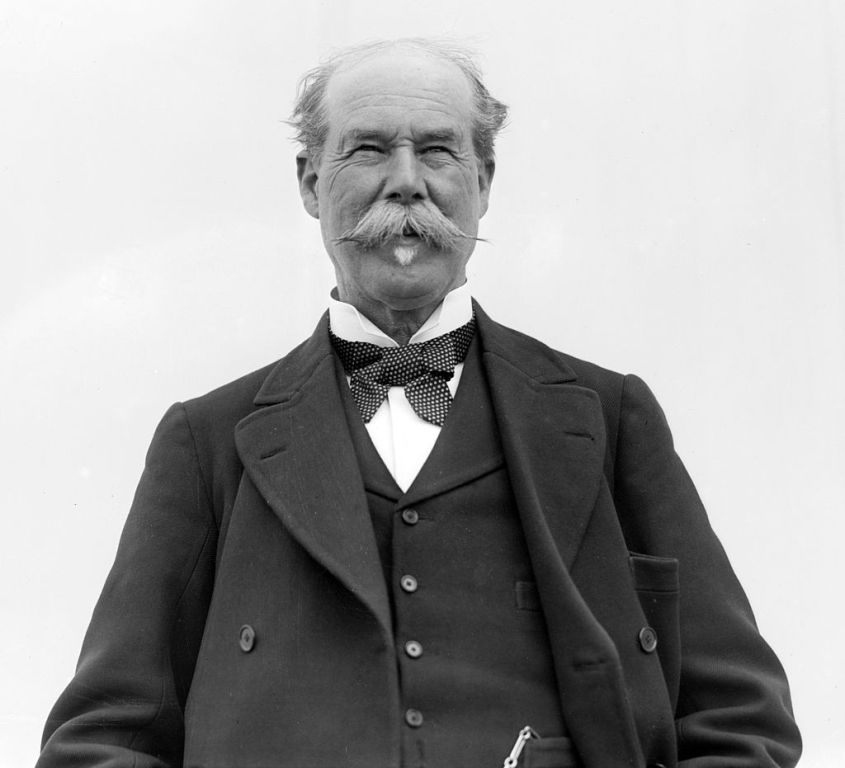
Sir Thomas Lipton CALL NUMBER: LC-B2- 911-12[P&P] REPRODUCTION NUMBER: LC-DIG-ggbain-04327 1909. NOTES: Forms part of: George Grantham Bain Collection (Library of Congress).
Personal life
Lipton was sometimes described in the press as 'the world's most eligible bachelor', and carefully cultivated a public image as a 'ladies man'. He never had a relationship with a woman, using as the excuse that none measured up to his mother. Instead, he maintained a thirty-year relationship with one of his early shop assistants, William Love, with whom he lived. When they parted other male companions followed, including an orphan from Crete whom Lipton met during a cruise in 1900. A close friend was Maurice Talvande, the self-styled Count de Mauny.
Lipton came to his home, Osidge, in Southgate, London, from Muswell Hill in 1892. Before moving in, he redecorated the house completely, built a new billiards room and moved the existing pathway as far away from the house as possible. Before the coming of the motor car, his home's newly enlarged stables contained at least three pairs of fast carriage horses, of which he was proud. He was driven to his offices in City Road each day, and did not use the nearby railway.
During World War I, Sir Thomas Lipton helped organizations of medical volunteers. He placed his yachts at the disposal of the Red Cross, the Scottish Women's Hospitals Committee of Dr. Elsie Inglis, the Serbian Supporting Fund, etc., for the transport of medical volunteers (doctors and nurses) and medical supplies. In Serbia during the winter of 1914–1915 and the spring of 1915, several British hospital teams were working with Serbian military and civilian doctors and nurses. A catastrophic typhus epidemic erupted, killing thousands of civilians, soldiers, and prisoners of war; medical staff, however, were among the first victims. At the height of the epidemic, Sir Thomas Lipton decided to visit Serbia, traveling aboard his yacht Erin via Sardinia, Malta, Athens, and Thessaloníki. Once in Serbia, he visited hospitals and medical missions in Belgrade, Kragujevac, Niš, Vrnjačka Banja, and elsewhere. His modesty made him very popular among the people. He asked only for modest lodgings and requested for meals only what the common people ate under war conditions. He also liked to pose for photographs with Serbian officers and soldiers. In addition to visiting many hospitals, where he encouraged doctors, nurses and soldiers, he found time to attend traditional fairs and to take a part in blackberry gathering and fishing. Sir Thomas Lipton was proclaimed an honorary citizen of the city of Niš.
Author Herbert W Newby writes in a book about Southgate in 1949: "Sir Thomas was proud of his successes in life, and any reference to him made in any publication was always carefully cut out and pasted into a book kept for this purpose. These books formed a most interesting section of his library. He was a very genial man to meet and always put a stranger quickly at ease. I met him on several occasions and found him without any form of snobbery."
He was created a Knight Commander of the Royal Victorian Order (KCVO) by King Edward VII in March 1901. The following year, it was announced that he would receive a baronetcy in the 1902 Coronation Honours list published on 26 June 1902 for the (subsequently postponed) coronation of the King, and on 24 July 1902 he was created a Baronet, of Osidge, in the Parish of Southgate, in the County of Middlesex. A portrait of Lipton appeared on the cover of Time magazine on 3 November 1924.
He died at Osidge on 2 October 1931 and bequeathed the majority of his fortune to his native city of Glasgow, including his yachting trophies, which are now on display at the Kelvingrove Art Gallery and Museum. Sir Thomas Lipton was buried alongside his parents and siblings in Glasgow's Southern Necropolis.
Thomas Lipton. (2017, February 13). In Wikipedia, The Free Encyclopedia. Retrieved from https://en.wikipedia.org/w/index.php?title=Thomas_Lipton&oldid=765258935
We close where we opened, and possibly find why the Shamrock V and the ill-fated 1914 America's Cup warranted a tribute or an hurrah from Australians still connected to Pittwater a few years before the Royal Prince Alfred Yacht Club moved to the shores of the Pittwater estuary permanently.
The report that follows the recap of that year's Pittwater Regatta would most certainly have been read by all who made that year's regatta a success and the waste of such a magnificent yacht would have distressed these local yachtsmen.
RACING ON SHAMROCK IV.
MR. WALTER MARKS AT COWES
Writing to Captain Mark Brasch, of Sydney,, Mr. Walter Marks, the well-known local yachtsman, relates that he was at Cowes early In August. He was racing on Sir Thomas Lipton's Shamrock IV. nearly every day, and was on the mainsheet, at which he was was not disgracing Australia.The yacht won the Cowes Royal Yacht Squadron's Cup on the 7th ult„ under full sail in a nor'-west gale'. The Sydney yachtsman remarks, ''It was a treat.". RACING ON SHAMROCK IV. (1908, September 8). The Australian Star (Sydney, NSW : 1887 - 1909), p. 1 (FIRST EDITION). Retrieved from http://nla.gov.au/nla.news-article229100292
SHAMROCK IV. ,
Trip Across Atlantic Ocean YACHTING EXPERIENCES OF MR WALTER MARKS. M.H.R.
In the year 1914 and the months of July and August Sir Thomas Lipton's gigantic yacht Shamrock IV. crossed the Atlantic to compete for the America's Cup, the much coveted trophy for English and American yachting enthuiasts. The greatest and best known of English yachtsmen to-day is undoubtedly Sir Thomas Lipton, and the fame of his yachts is world wide. In the year 1914, just prior to the outbreak of war the yacht Shamrock IV. was launched at Portsmouth amidst unprecedented rejoicing and gaiety. The subsequent trials of the yacht and the trip across the Atlantic were graphically described at the Mechanics' Institute last night by an eye-witness, Mr Walter Marks, M.H.R., of Australia.
Mr Marks, one of Australia s foremost yachtsmen, was the guest of Thomas Lipton during the trial of the Shamrock IV., and the trip across to America.During that time he was busily engaged taking photos of the incidents of note surrounding the launching, the trials, and the final preparations for the Atlantic trip. The slides, which numbered about 200, were works of photographic art. The photos, especially those of the vessel in full rig and sailing before the wind were remarkable. The vessel was launched at Portsmouth, and after the ceremony was fully rigged and taken to Southend for her trials. Sir Thomas Lipton's steam yacht Erin, afterwards sunk by a submarine in the Mediterranean, accompanied the Shamrock IV., and as a trial horse, Lipton's other yacht Shamrock III, the fastest vessel for its size in the world, was used. Thousands of people were accustomed to lining the shores in the vicinity and watch the trials; unusual interest being manifested by the whole of the English people.
Throughout the course of the lecture Mr Marks described the rigging and the novelties introduced in the building by the designer, Mr Chas. Nicklesen. The mast, even to those unaccustomed to noting such things, appeared an enormous structure, the measurement being 168ft. from the deck. She carried a spread of canvas 13,000 square feet, and the boom stood over 7ft from the decking. Only a slide of a character exhibited last night could convey an idea of tremendous size of the yacht. The entire navigating crew were chosen experts selected from the pick of England's yachtsmen, and to a man they took a pride in their work. The weight of everything on board was tremendous, yet despite this fact the rigging was only of a light character. The crew comprised 32 men competent in their various departments, in the trials the Shamrock IV. was capable of giving Shamrock III. 45 seconds start in every mile and then win. The latter vessel at the time of the trials was the fastest cutter in the world. Prior to setting out across the Atlantic the vessel was at Spithead when the naval review was held, and in starting on the voyage was compelled to pass through 21 miles of steel composed of the might of the English navy. A great ovation was accorded the crew's of both the Erin and the Shamrock IV., which was in tow.
After leaving the English coast the course lay south of the the Azores, at which islands both the Erin and the Shamrock IV put in for provisions and water. After leaving the Azores the wireless operator on board the Erin picked up a message stating that England had declared war on Germany. Shortly afterwards the Erin intercepted German code signals which the operator confirmed as coming from Von Spee's squadron. Following this message another was received from Mr Winston Churchill ordering the two vessels to put into Bermuda for safety. The Erin and Shamrock IV., both succeeded in reaching Bermuda, and after sheltering for a few days continued the voyage to America which proved uneventful.
A magnificent reception was accorded them upon arrival in New York Harbor, but since the war was in progress it was decided to dock the vessel until the cessation of hostilities. It was only recently that the Shamrock IV. appeared in public, and in the race for the America Cup was defeated by the Resolute. In conclusion. Mr Marks stated that Sir Thomas Lipton was not, as many people thought, in the game for advertisement. So enthusiastic was he over yachting, and so keen was he to win the America Cup, that in his will he had left money for the endeavor to be achieved after his death. The interesting lecture was brought to a close by a vote of thanks being passed to the lecturer. Mr Marks will deliver this Iecture in Hobart shortly.SHAMROCK IV. (1921, February 24). Daily Telegraph (Launceston, Tas. : 1883 - 1928), p. 7. Retrieved from http://nla.gov.au/nla.news-article153082724
YACHTING
PITTWATER REGATTA ON NEW YEAR'S DAY Big Events Won By Magic And Wanderer: Great Sport
(By PELORUS)
The first regatta at Pittwater since 1914 was held on New Year's Day with signal success and every indication that before long the fixture will become one of the most important and popular aquatic events in the State. The magnificent stretch of water, which bears the name, forms the southern arm of Broken Bay, and extends from Lion Island to Newport, furnishing, in its picturesque setting, of sheltering hills, an ideal situation for sailing and rowing races
Last Saturday Pittwater was in gala costume. The steamer Gosford was flagship, and was crowded with spectators, and there was a large attendance of sailing craft and launches, mostly gaily decked with bunting, the whole making a brilliant combination of animation and color. There were two yacht races — an all yachts' handicap, for a trophy presented by Sir Rupert Clarke, and other prizes, which was won convincingly by Magic; and a general handicap for cruisers for a cup presented by Mr. James J. Smith, president of the regatta, and prizes, which was secured by Wanderer, a handsome covered cruising boat, which was recently built by Mr. C. M. Gale at his yards, Lane Cove.
In the evening an official dinner was held at the Newport Hotel, Mr. James J. Smith presiding. Among the many present were General Sir G. Ryrie, M.P., (Assistant-Minister), Mr. Walter Marks M.P. (commodore of the Royal Prince Alfred Yacht Club), Mr. Weaver. M. L. A., Mr. J. Williams, Mr. F. J. S. Young, Mr. Milne (commodore of the Motor Yacht Club of N.S. Wales), Mr. Frank Albert, and Mr. Fred Adams (the doyen of yachting in Port Jackson). There were many toasts, and much was said in praise of the regatta.
THE RACING.
For the racing the weather conditions were perfect. The breeze in the bay was light from north-east. In the. all yachts' handicap there were six starters : Bradley and Towse's Bona (R. L. Patrick), scr; J. C. Palmer's Aoma (J. B. Palmer), llmin; C. T. Brockhoff's Scotia (owner), 18min; H. B. Langley's Magic (A. Stevens), 16min; S. H. Fairland's Manoya (owner), 24min and A. Boesen's Ithra (S. M. Dempster), 34min. The conditions were favorable to Magic, which early forged her way to the front, and she led the first time round the flagship, followed in order by Scotia, Ithra, Aoma, Manoya and Bona. Aoma sailed under disadvantage, carrying small sail owing to an accident that had occurred the previous day. Rounding the flagship the second time, Bona was in third position. Scotia, which at first kept close on the heels of Magic, broke her spinnaker boom and suffered as a consequence. Eventually Magic won from Scotia by 4min 21sec, the latter crossing the line 1min 42sec ahead of Bona. Aoma finished fourth. The course was 16 1/2 miles.
The cruisers' handicap attracted 10 starters: Triton (W. D. M. Taylor) and Seabird (F. Lomer), scr; Seabelle (R. A. McDonald), 4min; Mischief. (S. Spain), lOmin;' Athene (D. Carment, jun.) and Wanderer (E. C. Gale), 12min; Olive (S. H. Stevens) and Winifred (T. Ferry), 18min; Albacore (J. B. Wood), 23rriin, and Frolic (W. Rayment), 25min. Most of the .boats were slow in crossing the starting line. At. the first distance mark Olive was in the lead, and was immediately followed by Wanderer, and Mischief. On the run to the flagship something went wrong with Olive's spinnaker, and the lead was taken by Wanderer. In the breeze the scratch boats, Triton and Seabird, had no hope, but sailed an interesting match, which resulted in favor of the former. The race was won by Wanderer by 3min 22sec from Mischief, which took second place from Olive by 2min 10sec. The course was 11 1/2 miles.
'STRIPPED AND DESERTED.'
A New York message to the Herald (Paris edition) of November 12 says: — 'Yesterday the eyesore of all eyes, and one of the most important single objects on the face of the earth; to-day stripped and deserted, almost forgotten. Such is the sad fate of the Shamrock IV., Sir Thomas Lipton's famous yachting yacht. The long green sloop was a brilliant object, with its enormous spread of sail and a bevy of small craft constantly circling it, while critical eyes examined every feature of its remarkable lines. Today the green and white hull — it is green only down to the water-line — stands propped up high and dry in Jacob's shipyards at City Island, exposed to the elements. Only the deck is sheltered. The mast has been removed, as has all the equipment. A wooden roofing has been placed, tent-fashion, over the deck.'
PROPOSED BRITISH-AMERICAN CONTESTS.
'The contemplated races between American and British small-class yachts should provide an interesting feature in next season's racing in the Solent,' says The Yachtsman of November 11.' 'The idea has been maturing for some time. Early in the present year we referred to the probability of negotiations in this direction being opened by some American owners interested in small yacht racing. Informal correspondence was opened some few weeks' ago, and the proposal is now taking definite shape, meetings of prominent yachtsmen in this country haying been held to give' full consideration to it. 'There are several points. of detail that require to be carefully considered, as it is not a single challenge that has to be accepted, but a proposal for contests to take place in this, country and America alternately. .The first points that calls for decision is the selection of a class of yacht. It seems probable that the six metre International Class will be fixed upon, and it has everything to recommend its adoption. It is our smallest class provided for in the newest racing rule adopted by the International Yacht' Racing Union, and when we are considering international ' contests between boats which will require to be shipped across the Atlantic, there are obvious advantages in selecting the boats which can ,be carried most easily, fitted out expeditiuously after arrival, and are at the same time representative of our latest racing rule. 'Apparently the American yachtsmen arc inclined ' to favor this class, as we know enquiries have been made as to the type of boat a six-metre would be under the new rule. Enquiries of this nature arc quite natural, as, up to the present, no boats have been built to the standard rule of measurement. This again should make the contemplated contests all the more interesting, as designers on. both sides of the Atlantic will be called upon to produce craft in conformity with a rule with the formula; of which they have had no previous practical experience. 'Another point that comes up for consideration is whether the boats which meet the visitors shall be those which have proved themselves the best during the season up to the time of the contests. The six-metre class was a popular one in the Solent in pre-war days, and we may expect to see it revived in strength if these international contests should be definitely fixed up. It goes without saying that the ratification of the proposed contests will depend upon yachtsmen in this country undertaking to build vessels for the defence. Then, if the contests are to be held alternately in each country, American yachtsmen will want to be assured of their visit being returned.
'We understand that' a six-metre class is to be established on the Clyde. If this class should be the one ultimately selected for the contests, it is' only to be expected that Clyde owners would like to be given the opportunity of becoming contestants. This might possibly lead to some eliminating trials in' the Solent, which would further add to the interest in the whole contests. ' 'We would like to see amateur crews a condition, of such contests.
Under the 'I.Y.R.U. rules, a six-metre craft is allowed to have two paid hands. If, for such contests as are proposed, it were made a stipulation that, competing boats should be manned entirely by amateurs, it would be a move in- the right direction of encouraging Corinthian sailing. 'It is obvious that there are many details upon which agreement has to be arrived at before the contests, as proposed, are finally ratified, but the institution of an international rivalry on definite lines would be of more benefit to the sport than huge international festivals such as were carried out by the original I.Y.R.U.'
YACHTING (1921, January 5). Referee (Sydney, NSW : 1886 - 1939), p. 14. Retrieved from http://nla.gov.au/nla.news-article121155743
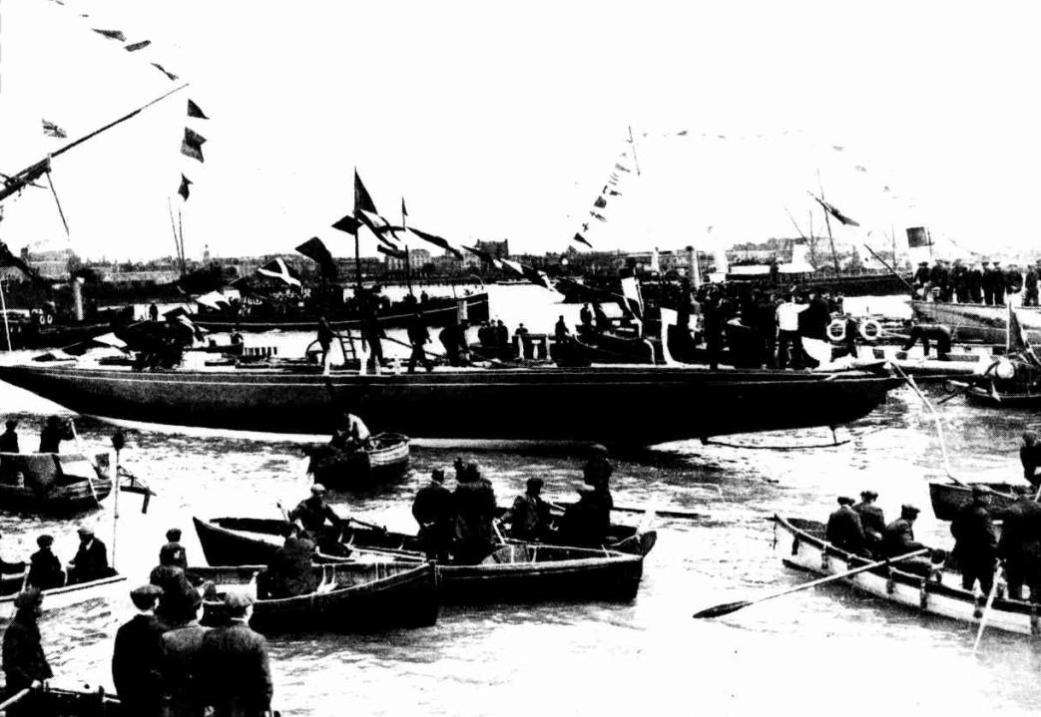
To Contest The America Cup : Sir Thomas Lipton's Shamrock IV., Recently Launched At Gosport (Eng.).
Particular interest attaches to this year's series of contests because of the fact that they will be held under a new rule of measurement, which discourages the building of the extreme and almost freakish type of yacht with which the public was familiar in the last series of contests. Sir Thomas Lipton's yacht was designed by Nicholson, one of the youngest and most successful designers in Great Britain, and it will be manned by as capable a crew of amateur yachtsmen as has ever entered an international race, not least among them being Mr. Walter M. Marks, of Sydney. The trials of Shamrock IV. have made Sir Thomas Lipton very confident of success.
Photo Sport and General. To Content the America Cup : Sir Thomas Lipton's Shamrock IV., recently Launched at Gosport (Eng.). (1914, July 1). Sydney Mail (NSW : 1912 - 1938), p. 24 (NEWCASTLE & DISTRICT SUPPLEMENT). Retrieved from http://nla.gov.au/nla.news-article166253592
An Australian and RPAYC Commodore Aboard an America's Cup Challenger of 1908 and 1914 - threads collected and collated by A J Guesdon, 2017